Class 10 Maths Chapter 13 Surface Areas and Volumes (English + Hindi) NCERT Solutions
- Ex.13.1
- Ex.13.2
- Ex.13.3
- Ex.13.4
- Ex.13.5
- Surface Areas and Volumes Class 10 Extra Questions
- Surface Areas and Volumes Class 10 Important Questions
- Surface Areas and Volumes Class 10 Notes
Ex 13.1 Class 10 Maths Question 1.
2 cubes each of volume 64 cm3 are joined end to end. Find the surface area of the resulting cuboid.
Solution: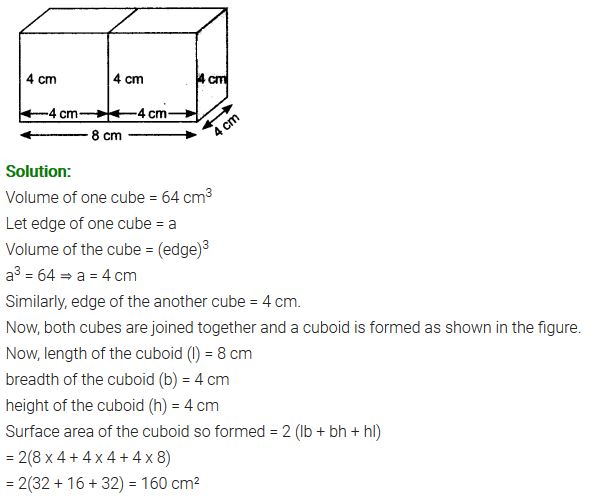
Ex 13.1 Class 10 Maths Question 2.
A vessel is in the form of a hollow hemisphere mounted by a hollow cylinder. The diameter of the hemisphere is 14 cm and the total height of the vessel is 13 cm. Find the inner surface area of the vessel.
Solution: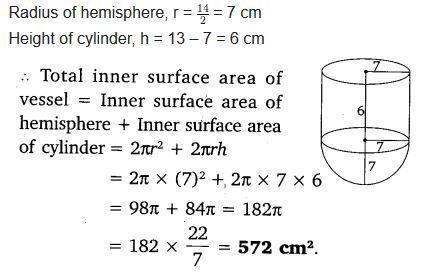
You can also download the free PDF of Ex 13.1 Class 10 Surface Areas and Volumes NCERT Solutions or save the solution images and take the print out to keep it handy for your exam preparation.
Download NCERT Solutions For Class 10 Maths Chapter 13 Surface Areas and Volumes PDF
Ex 13.1 Class 10 Maths Question 3.
A toy is in the form of a cone of radius 3.5 cm mounted on a hemisphere of the same radius. The total height of the toy is 15.5 cm. Find the total surface area of the toy.
Solution: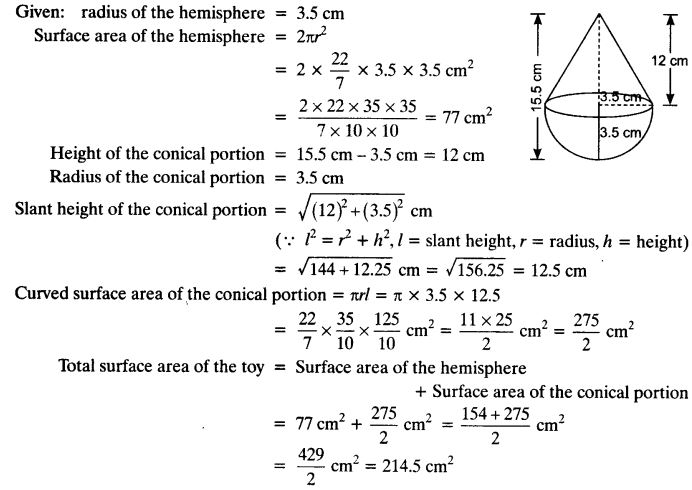
Ex 13.1 Class 10 Maths Question 4.
A cubical block of side 7 cm is surmounted by a hemisphere. What is the greatest diameter the hemisphere can have? Find the surface area of the solid.
Solution: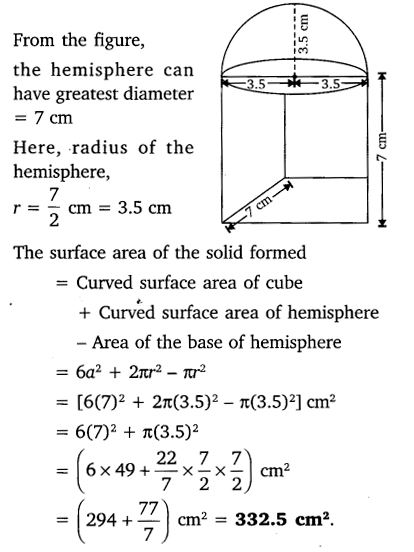
Ex 13.1 Class 10 Maths Question 5.
A hemispherical depression is cut out from one face of a cubical wooden block such that the diameter d of the hemisphere is equal to the edge of the cube. Determine the surface area of the remaining solid.
Solution: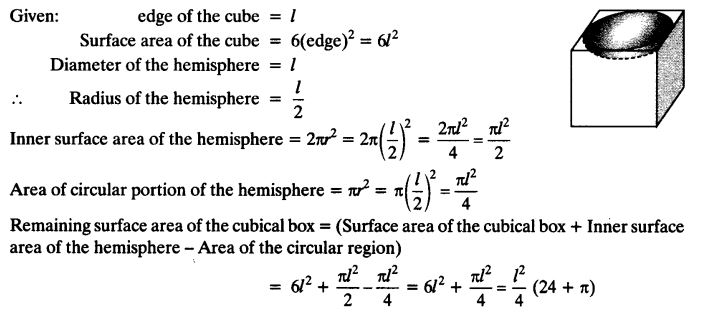
Ex 13.1 Class 10 Maths Question 6.
A medicine capsule is in the shape of a cylinder with two hemispheres stuck to each of its ends. The length of the entire capsule is 14 mm and the diameter of the capsule is 5 mm. Find its surface area.
Solution: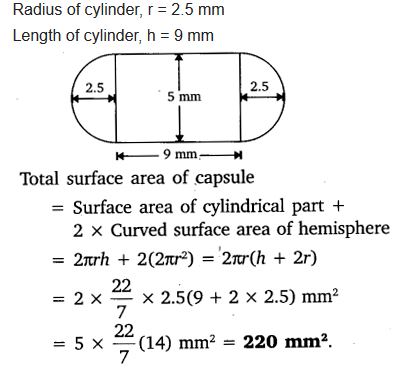
Ex 13.1 Class 10 Maths Question 7.
A tent is in the shape of a cylinder surmounted by a conical top. If the height and diameter of the cylindrical part are 2.1 m and 4 m respectively, and the slant height of the top is 2.8 m, find the area of the canvas used for making the tent. Also, find the cost of the canvas of the tent at the rate of Rs 500 per m2. (Note that the base of the tent will not be covered with canvas.)
Solution: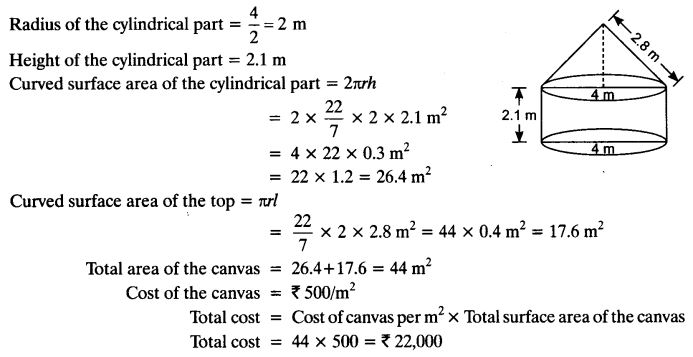
Ex 13.1 Class 10 Maths Question 8.
From a solid cylinder whose height is 2.4 cm and diameter 1.4 cm, a conical cavity of the same height and same diameter is hollowed out. Find the total surface area of the remaining solid to the nearest cm2.
Solution: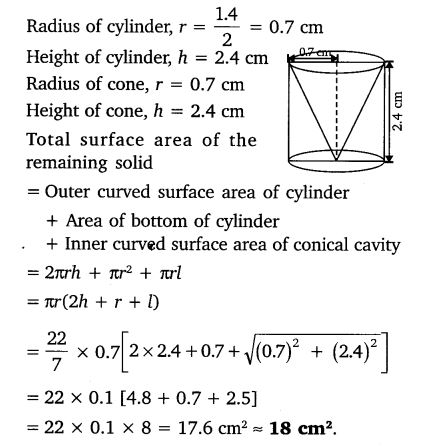
Ex 13.1 Class 10 Maths Question 9.
A wooden article was made by scooping out a hemisphere from each end of a solid cylinder, as shown in figure. If the height of the cylinder is 10 cm, and its base is of radius 3.5 cm, find the total surface area of the article.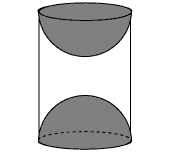
Solution: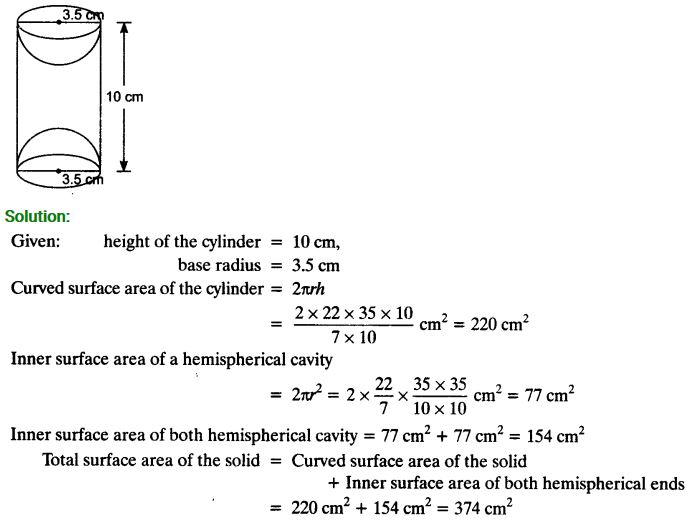
Class 10 Maths Surface Areas and Volumes Mind Maps
Surface Areas and Volumes of Solids
(i) Cuboid:
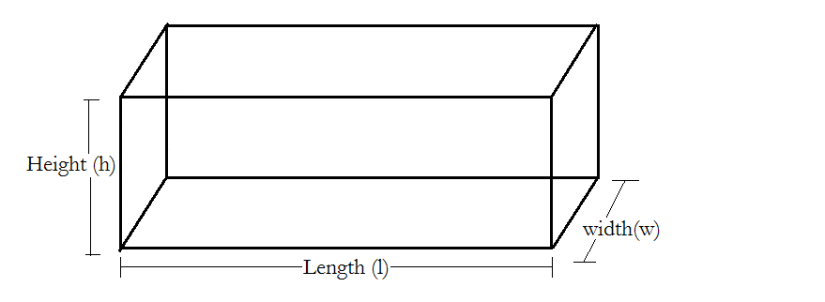
Volume = l × b × h
Total surface area = 2 [lb + bh + hl]
Lateral surface area = 2 [bh + hl]
Diagonal of the coboid =
(ii) Cube:

Volume = a3
Total surface area = 6a2
Lateral surface area = 4a2
Diagonal of a cube = √3a
(iii) Cylinder:

(a) Right circular cylinder:

Volume = πr2h
Curved Surface Area = 2nrh
Total Surface Area= 2πrh + 2πr2 = 2πr(r + h)
(b) Right circular hollow cylinder:
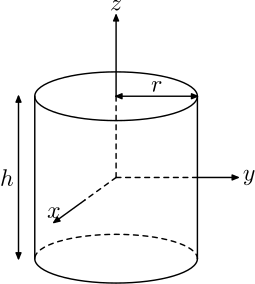
Let r and R be internal & external radii.
Volume = n(R2 – r2)h
Curved Surface Area = 2π(R + r)h
Total Surface Area = 2π(R + r)h + 2π(R2 – r2)
= 2π(R + r)(h + R — r)
(iv) Right circular cone:
Slant height, l = 
Volume =
Curved Surface Area = πrl
Total Surface Area = πrl + πr2
Surface Areas and Volumes of Sphere and Hemisphere
(i) Sphere:

Volume =
Surface area =4πr2
(ii) Hemisphere:

Volume =
C.S.A = 2πr2
T.S.A = 3πr2
(iii) Hemispherical shell:

Volume =
Curved Surface Area = 2π(R2 + r2)
Total Surface Area = 2π(r2 + R2) + n (R2 – r2)
= π (r2 + 3R2)
Surface Areas of a Combination of Solids
The surface area of a solid which is a combination of two or more solids is calculated by adding the surface areas of the individual solids which are visible in the new solid formed.
For Example:
If we consider the surface of the newly formed object as given in the figure above, we would be able to see only the curved surfaces of the two hemispheres and the curved surface of the cylinder.
So, the total surface area of the new solid is the sum of the curved surface areas of each of the individual parts. This gives, TSA of new solid = CSA of one hemisphere + CSA of cylinder + CSA of other hemisphere
Volume of a Combination of Solids
Whenever solid is formed by combining two or more solids, then the amount of matter present in the new solid is equal to the sum of amounts of matter in the constituting solids. Volume of new solid = sum of the volumes of the individual solids
Conversion of Solid form One Shape to Another
(i) When a solid is converted from one shape to other, then its volume remains same only its shape and size changes.
(ii) If a solid is converted into a number of small identical solids, then Number of small items
Frustum of a Cone [Very Important for Board Exam]
When we slice (or cut) through a cone with a plane parallel to its base (see below figure ) and remove the cone that is formed on one side of that plane, the part that is now left over on the other side of the plane is called a frustum of the cone.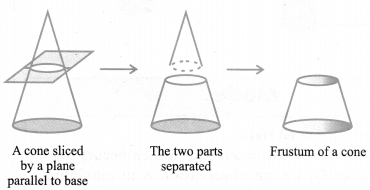
(i) Volume of the frustum of cone
(ii) C.S.A. of the frustum of cone = π(r1 + r2)l,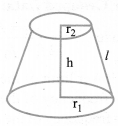
where l =
(iii) T.S.A. of the frustum of cone
l =
NCERT Solutions for Class 10 Maths Chapter 13 Surface Areas and Volumes (Hindi Medium) Ex 13.1

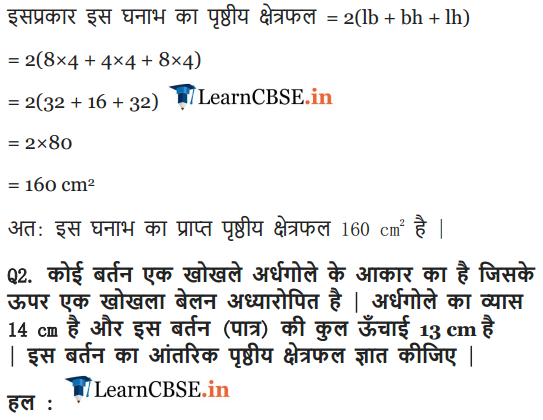
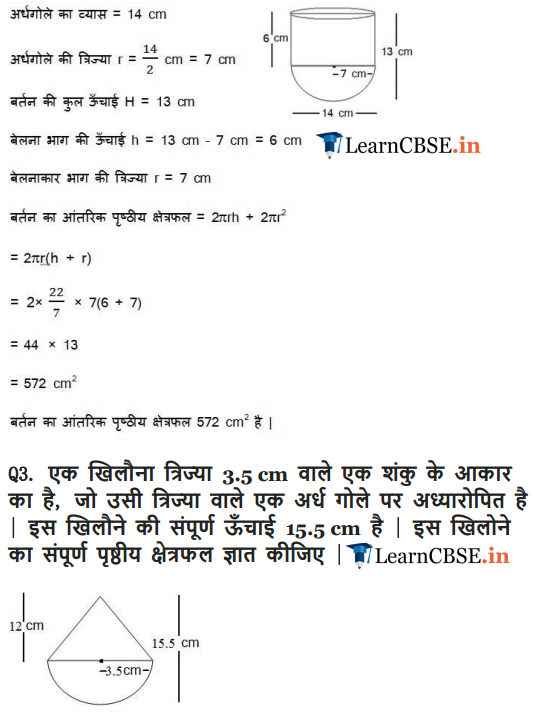
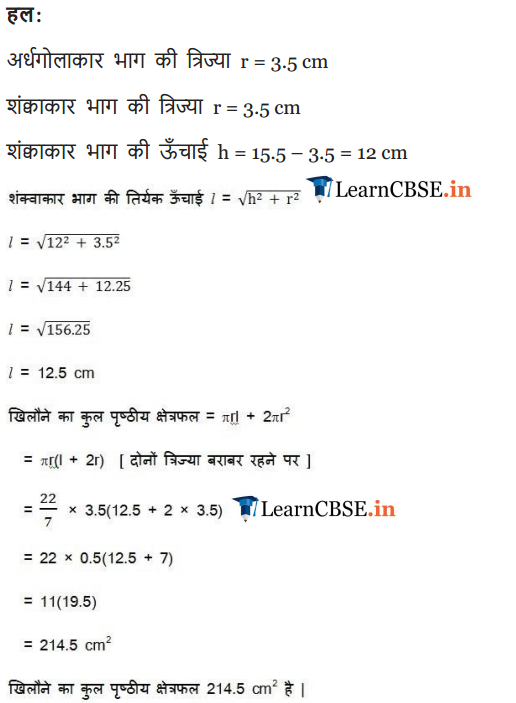
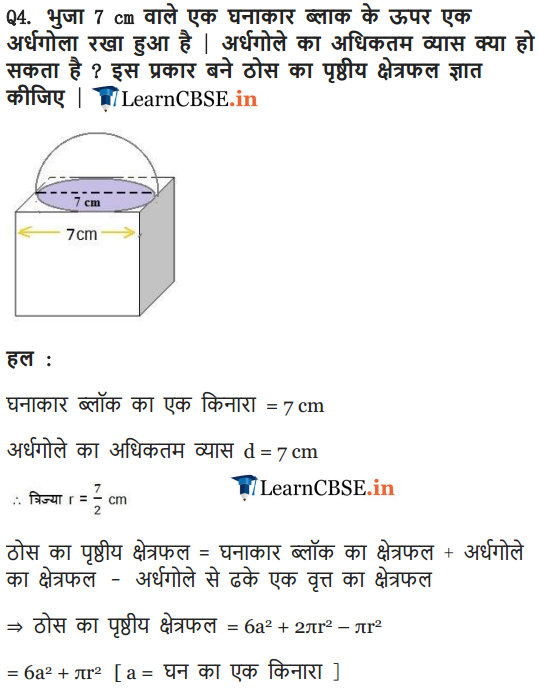
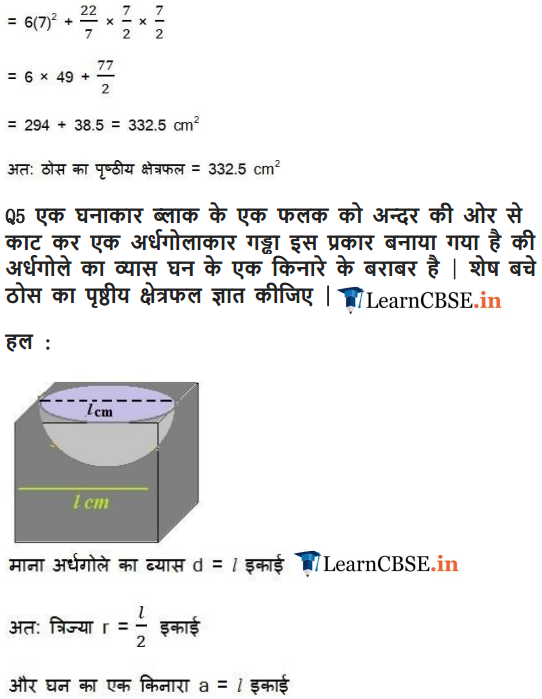
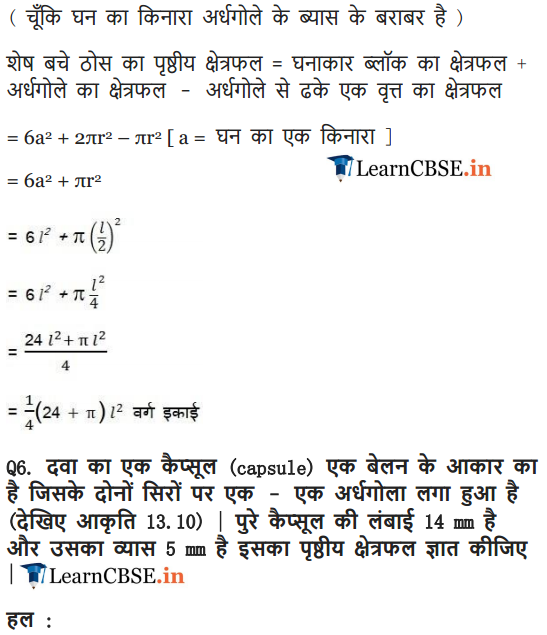
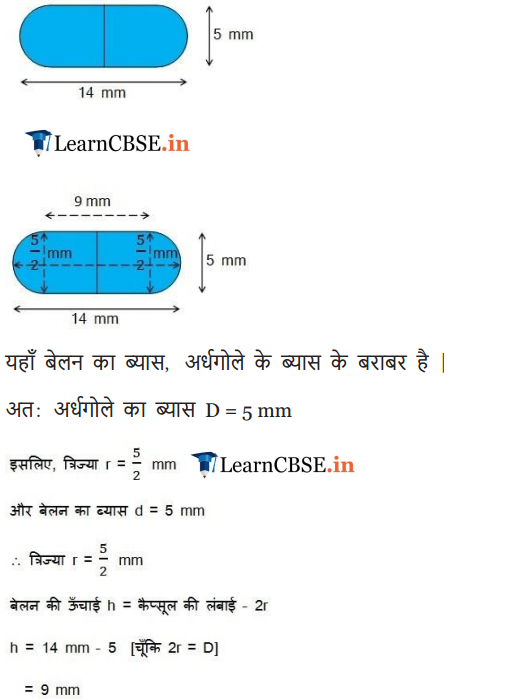
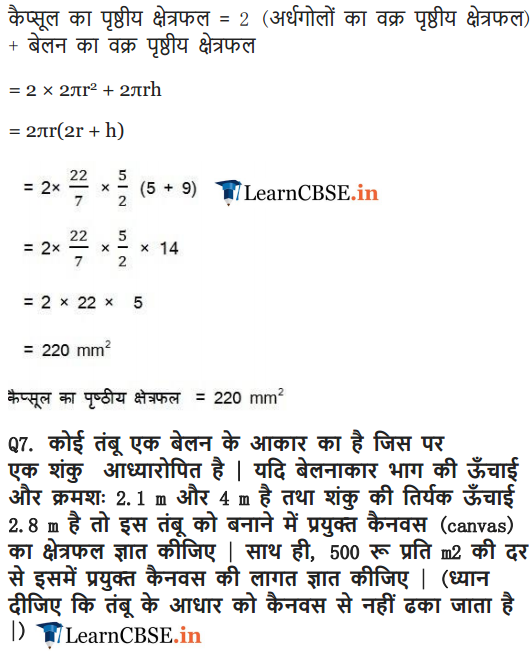
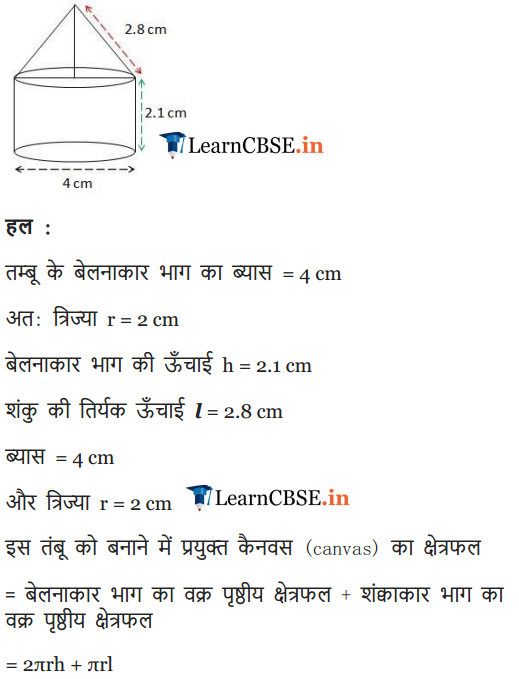
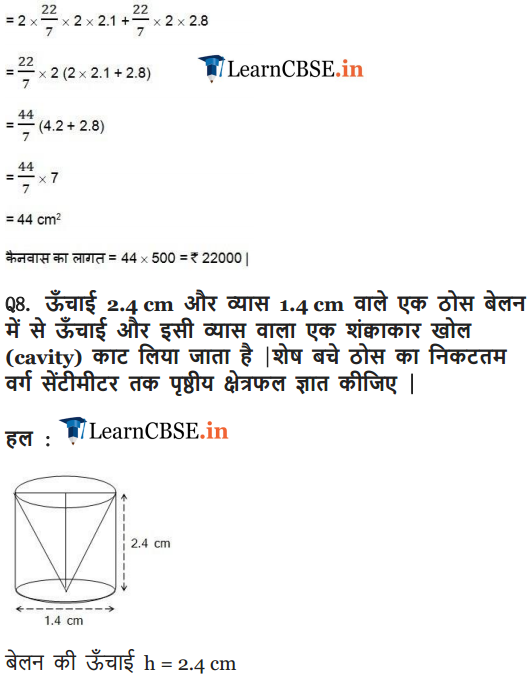
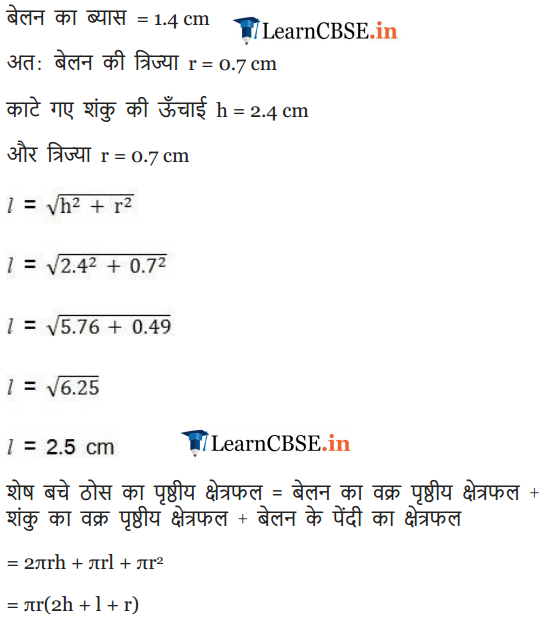
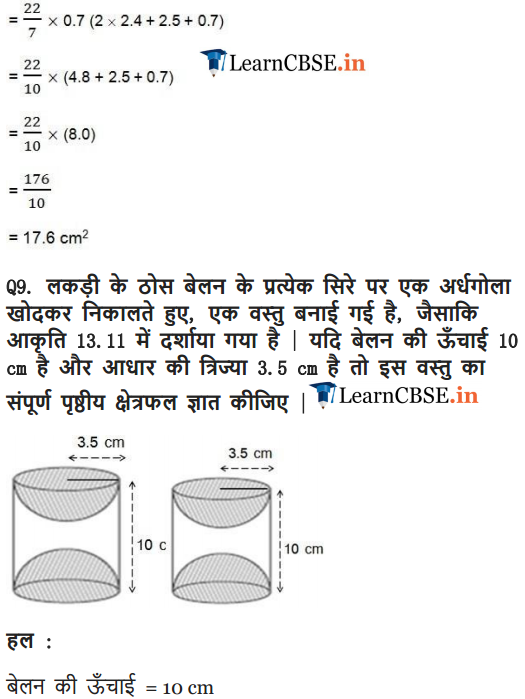
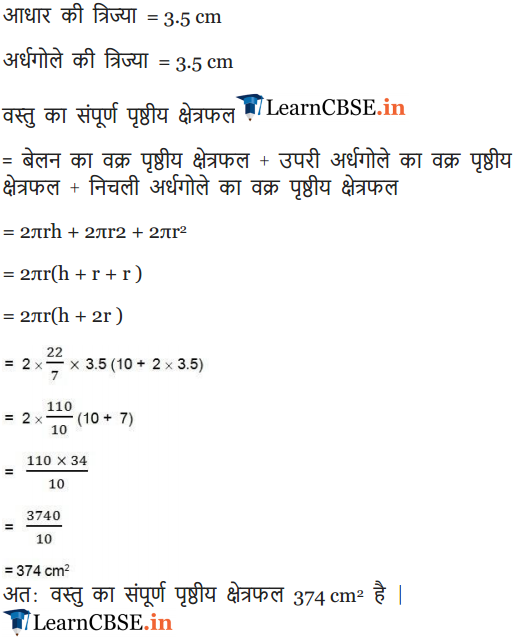
Class 10 Maths Chapter 13 Surface Areas and Volumes Ex 13.2
Ex 13.2 Class 10 Maths Question 1.
A solid is in the shape of a cone standing on a hemisphere with both their radii being equal to 1 cm and the height of the cone is equal to its radius. Find the volume of the solid in terms of π.
Solution: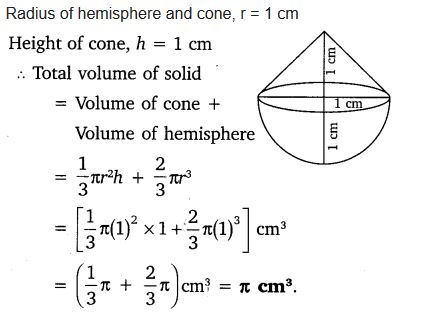
Ex 13.2 Class 10 Maths Question 2.
Rachel, an engineering student, was asked to make a model shaped like a cylinder with two cones attached at its two ends by using a thin aluminium sheet. The diameter of the model is 3 cm and its length is 12 cm. If each cone has a height of 2 cm, find the volume of air contained in the model that Rachel made. (Assume the outer and inner dimensions of the model to be nearly the same.)
Solution: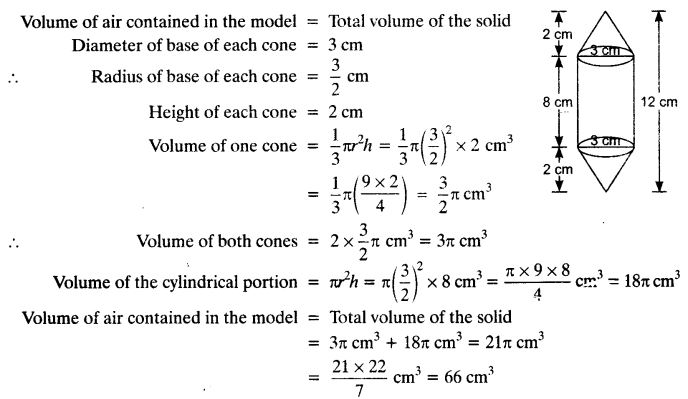
Download NCERT Solutions For Class 10 Maths Chapter 13 Surface Areas and Volumes PDF
Ex 13.2 Class 10 Maths Question 3.
A gulab jamun, contains sugar syrup up to about 30% of its volume. Find approximately how much syrup would be found in 45 gulab jamuns, each shaped like a cylinder with two hemispherical ends with length 5 cm and diameter 2.8 cm.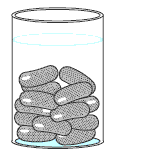
Solution: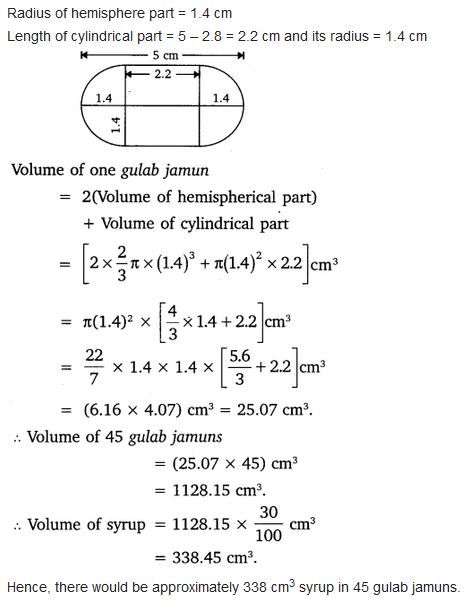
Ex 13.2 Class 10 Maths Question 4.
A pen stand made of wood is in the shape of a cuboid with four conical depressions to hold pens. The dimensions of the cuboid are 15 cm by 10 cm by 3.5 cm. The radius of each of the depressions is 0.5 cm and the depth is 1.4 cm. Find the volume of wood in the entire stand.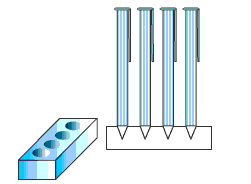
Solution: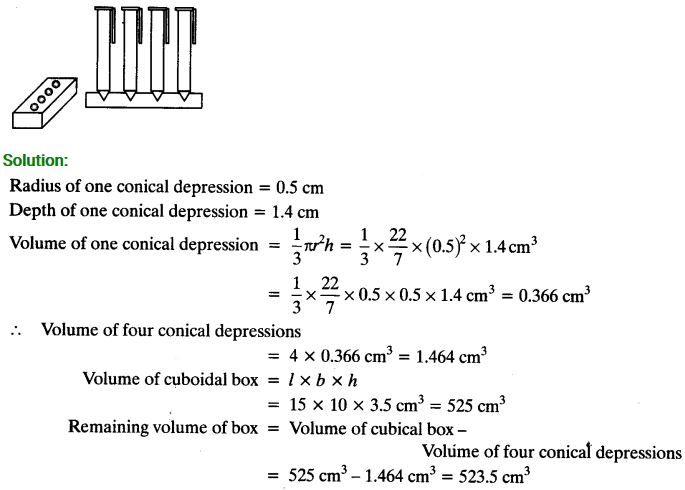
Question 5.
A vessel is in the form of an inverted cone. Its height is 8 cm and the radius of its top, which is open, is 5 cm. It is filled with water up to the brim. When lead shots, each of which is a sphere of radius 0.5 cm are dropped into the vessel, one-fourth of the water flows out. Find the number of lead shots dropped in the vessel.
Solution: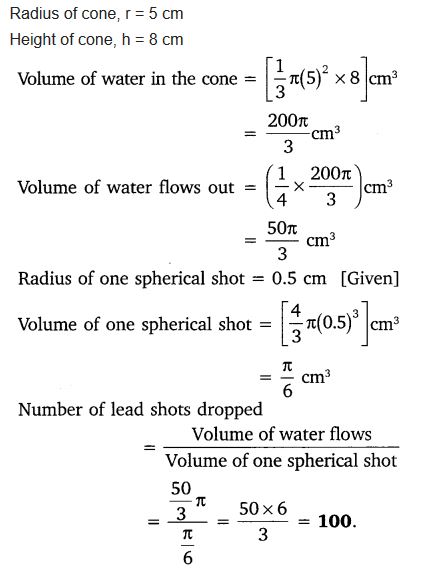
Ex 13.2 Class 10 Maths Question 6.
A solid iron pole consists of a cylinder of height 220 cm and base diameter 24 cm, which is surmounted by another cylinder of height 60 cm and radius 8 cm. Find the mass of the pole, given that 1 cm3 of iron has approximately 8g mass.
Solution: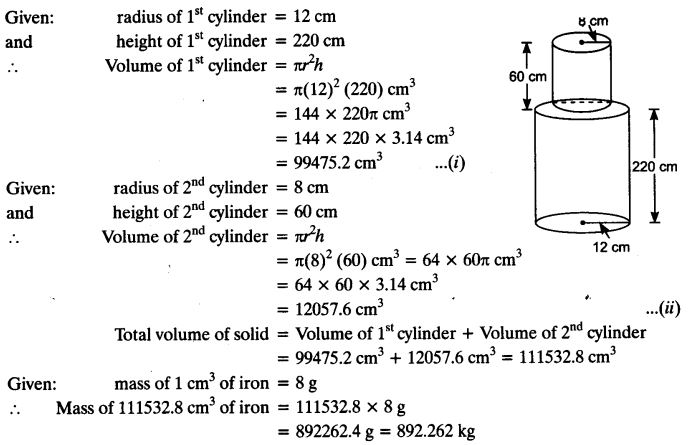
Ex 13.2 Class 10 Maths Question 7.
A solid consisting of a right circular cone of height 120 cm and radius 60 cm standing on a hemisphere of radius 60 cm is placed upright in a right circular cylinder full of water such that it touches the bottom. Find the volume of water left in the cylinder, if the radius of the cylinder is 60 cm and its height is 180 cm.
Solution: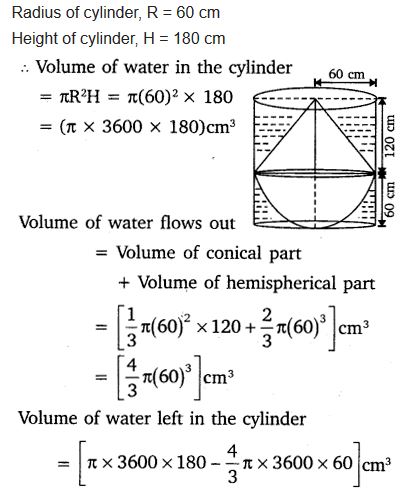
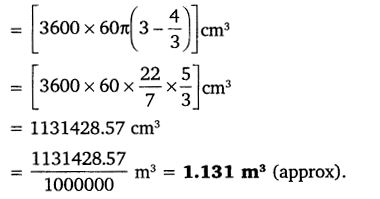
Ex 13.2 Class 10 Maths Question 8.
A spherical glass vessel has a cylindrical neck 8 cm long, 2 cm in diameter; the diameter of the spherical part is 8.5 cm. By measuring the amount of water it holds, a child finds its volume to be 345 cm3. Check whether she is correct, taking the above as the inside measurements, and π = 3.14.
Solution: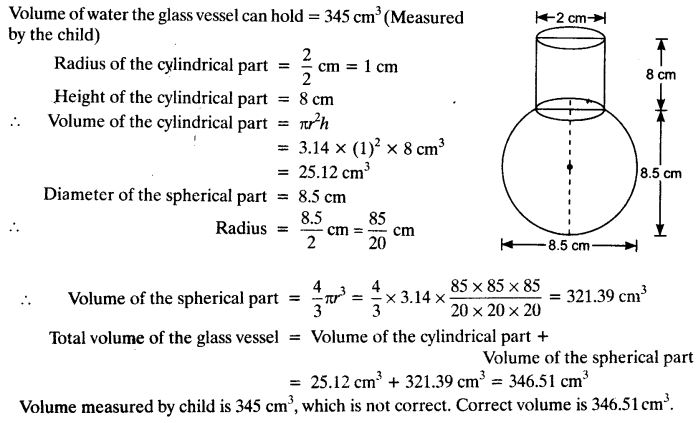
NCERT Solutions for Class 10 Maths Chapter 13 Surface Areas and Volumes (Hindi Medium) Ex 13.2
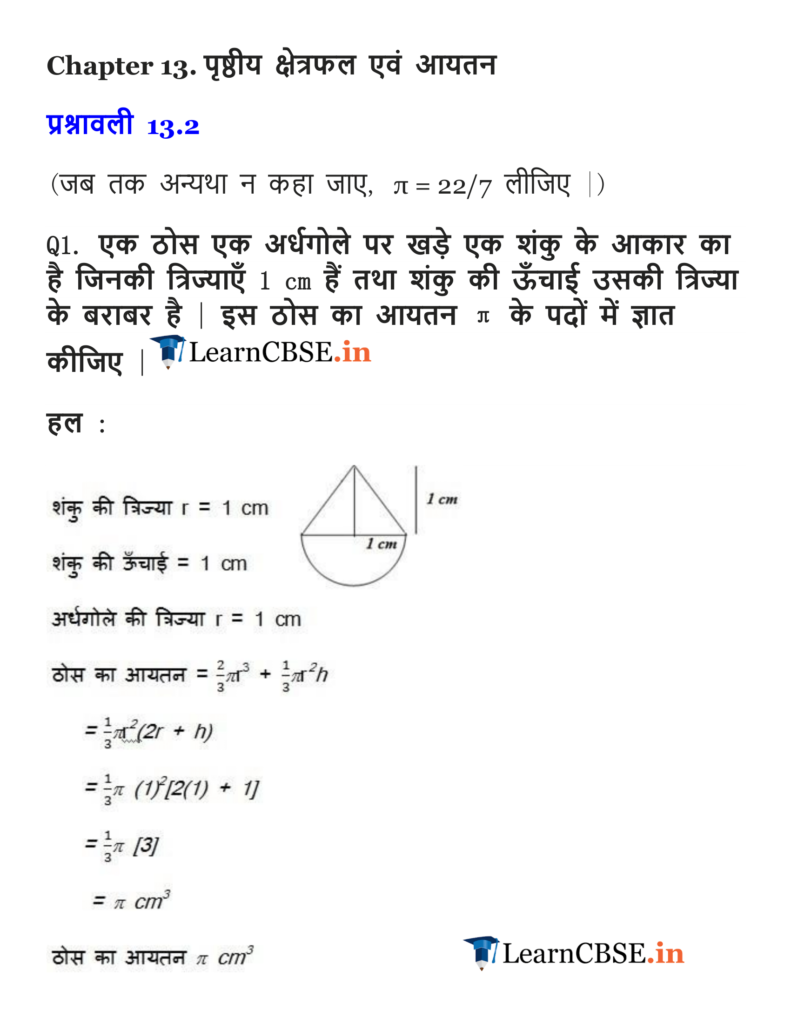
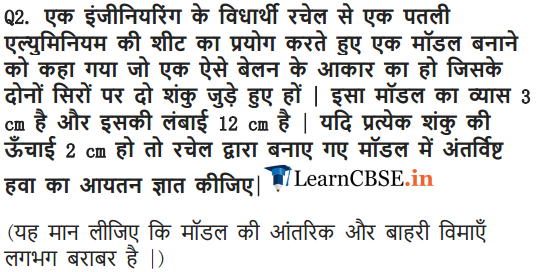
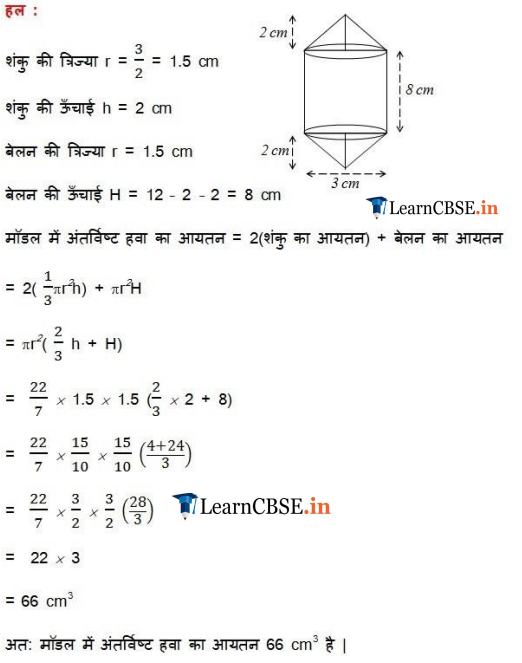
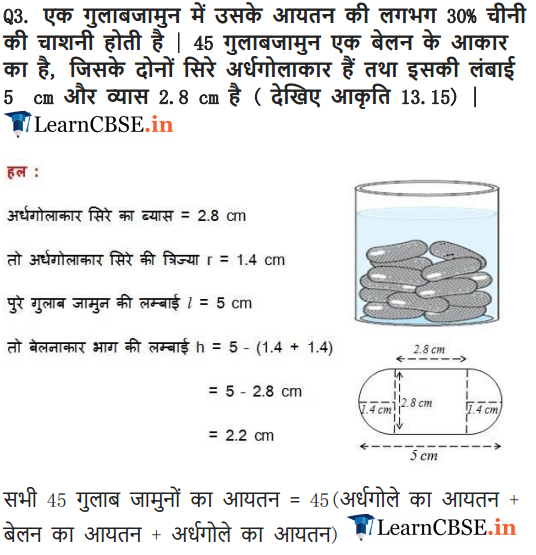
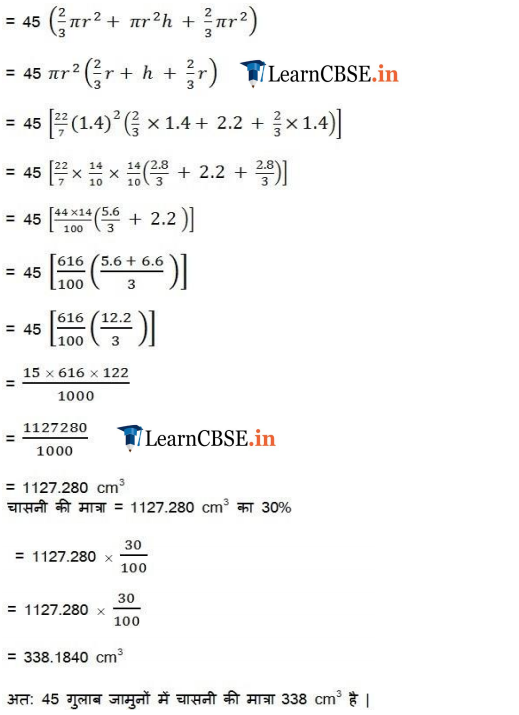
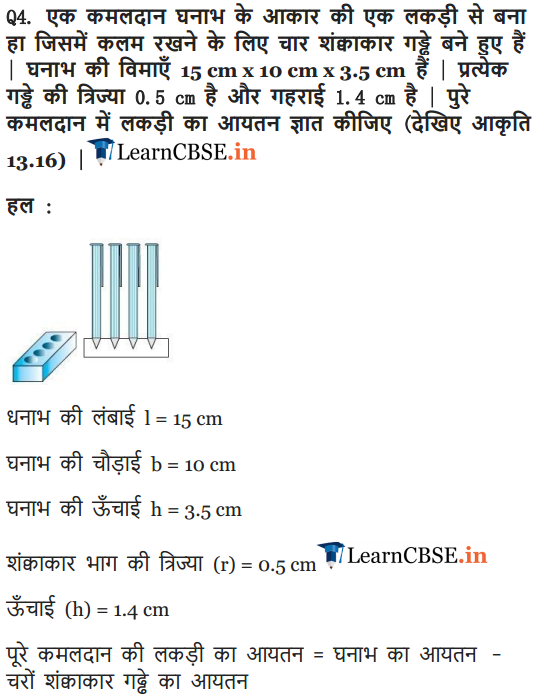
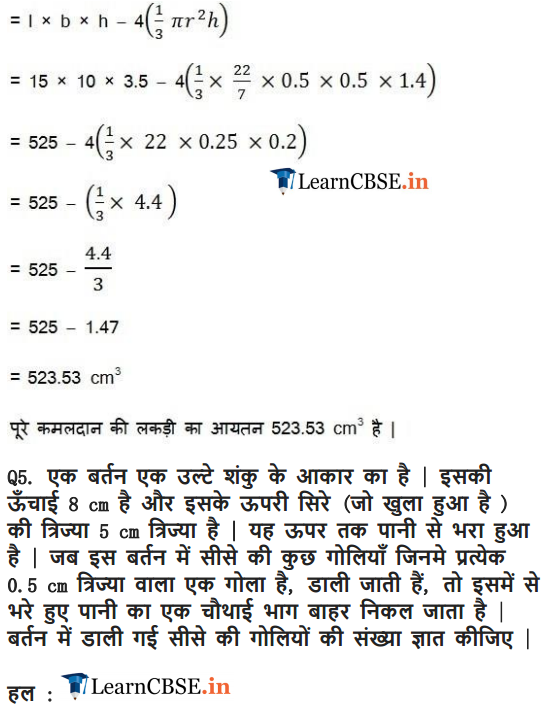
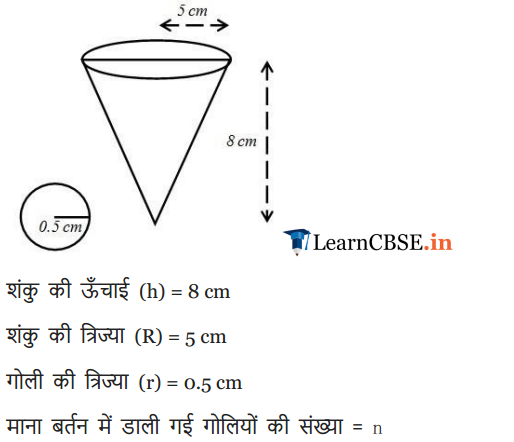
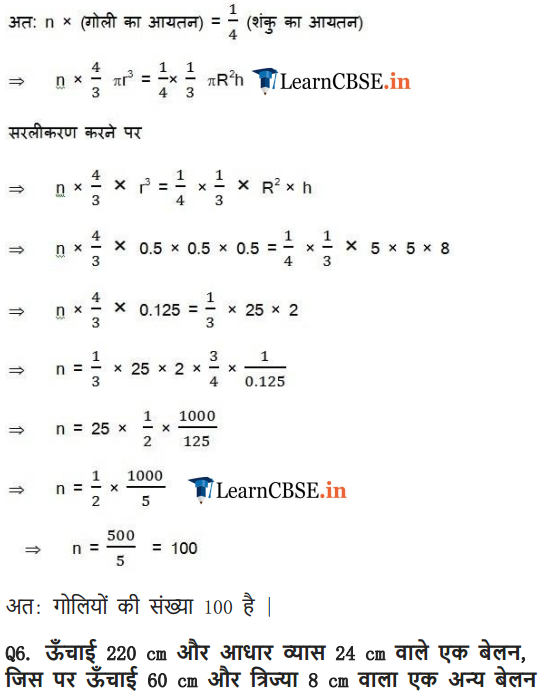
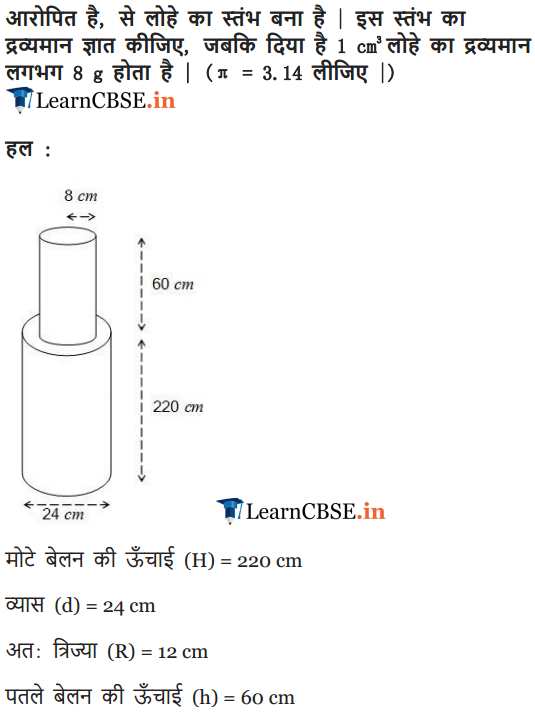
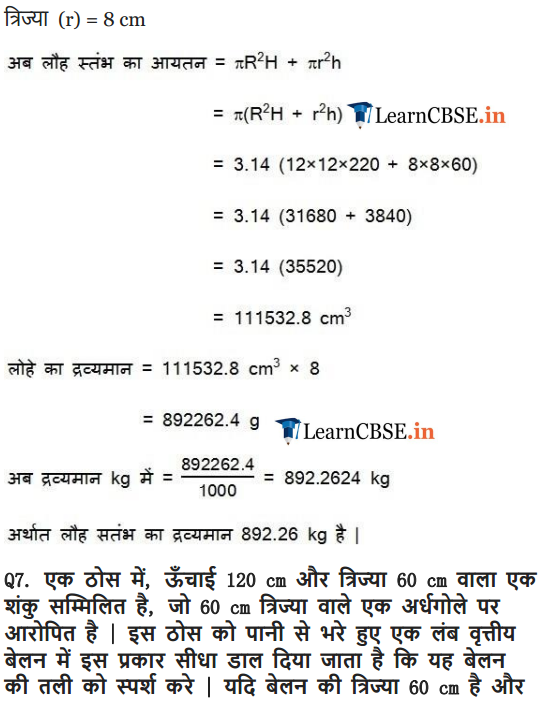
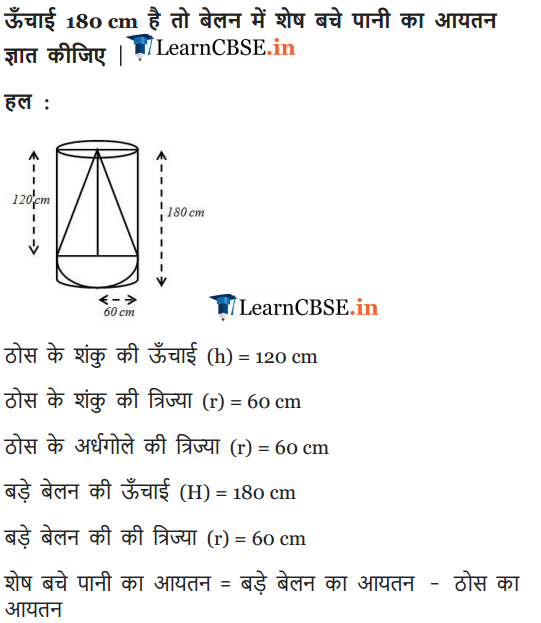
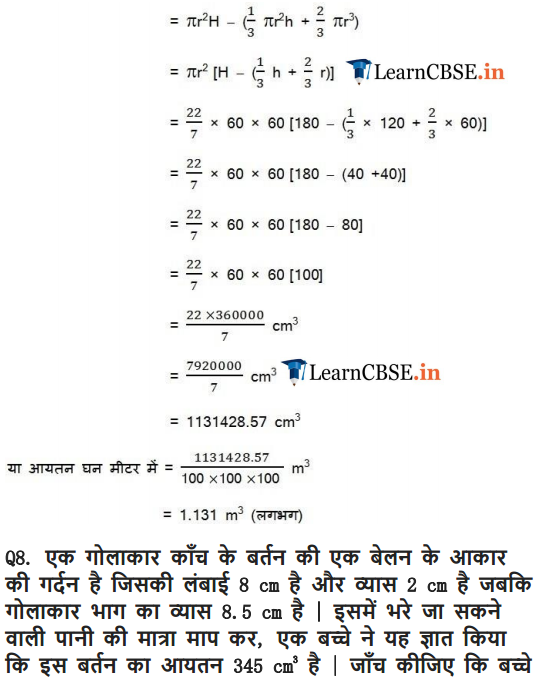
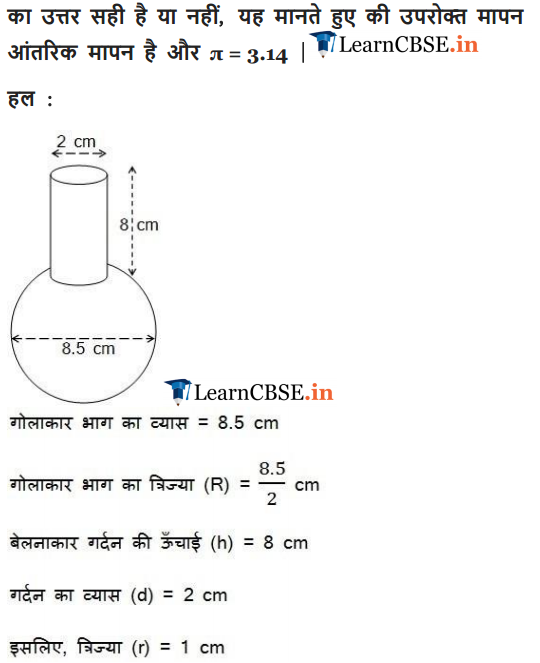
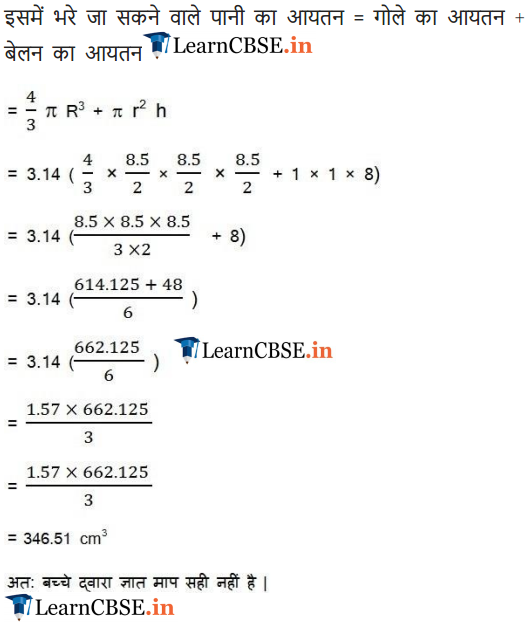
Class 10 Maths Chapter 13 Surface Areas and Volumes Ex 13.3
Ex 13.3 Class 10 Maths Question 1.
A metallic sphere of radius 4.2 cm is melted and recast into the shape of a cylinder of radius 6 cm. Find the height of the cylinder.
Solution: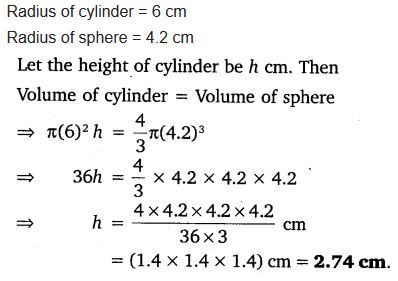
Ex 13.3 Class 10 Maths Question 2.
Metallic spheres of radii 6 cm, 8 cm and 10 cm, respectively, are melted to form a single solid sphere. Find the radius of the resulting sphere.
Solution: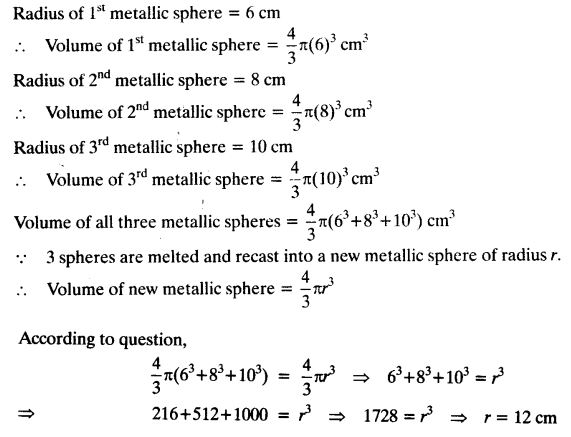
Download NCERT Solutions For Class 10 Maths Chapter 13 Surface Areas and Volumes PDF
Ex 13.3 Class 10 Maths Question 3.
A 20 m deep well with diameter 7 m is dug and the earth from digging is evenly spread out to form a platform 22 m by 14 m. Find the height of the platform.
Solution: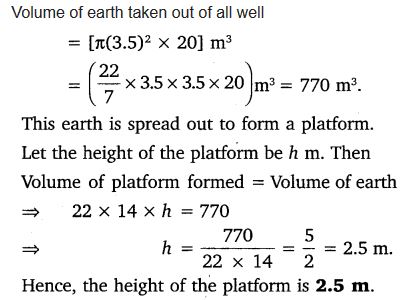
Ex 13.3 Class 10 Maths Question 4.
A well of diameter 3 m is dug 14 m deep. The earth taken out of it has been spread evenly all around it in the shape of a circular ring of width 4 m to form an embankment. Find the height of the embankment.
Solution: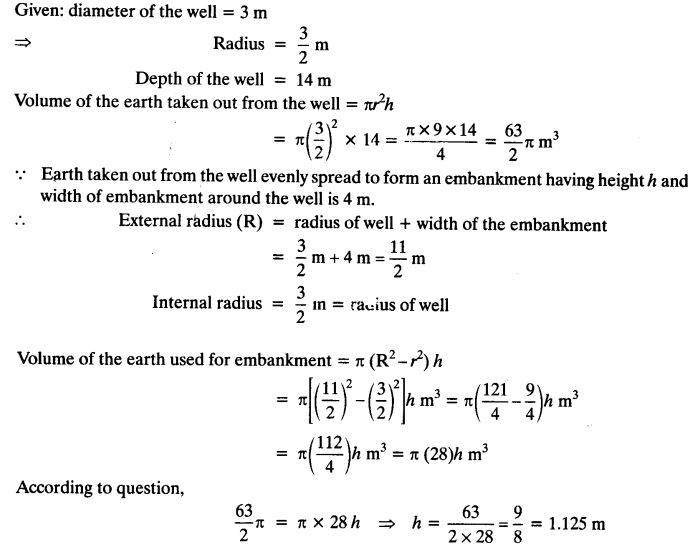
Ex 13.3 Class 10 Maths Question 5.
A container shaped like a right circular cylinder having diameter 12 cm and height 15 cm is full of ice cream. The ice cream is to be filled into cones of height 12 cm and diameter 6 cm, having a hemispherical shape on the top. Find the number of such cones which can be filled with ice cream.
Solution: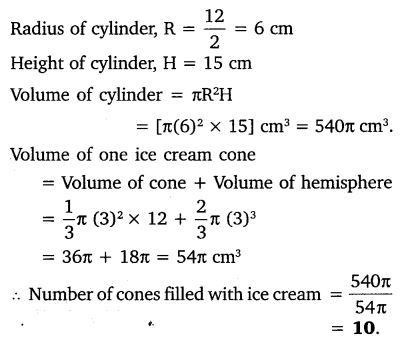
Ex 13.3 Class 10 Maths Question 6.
How many silver coins, 1.75 cm in diameter and of thickness 2 mm, must be melted to form a cuboid of dimensions 5.5 cm × 10 cm × 3.5 cm?
Solution: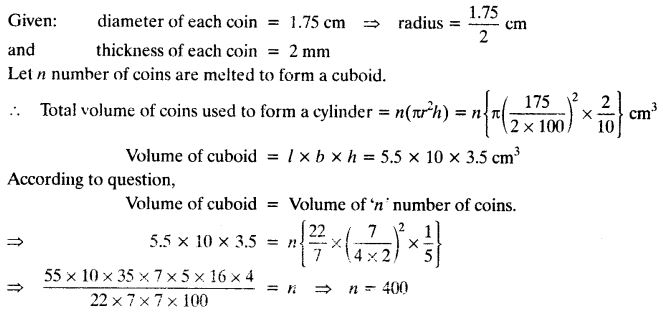
Ex 13.3 Class 10 Maths Question 7.
A cylindrical bucket, 32 cm high and with radius of base 18 cm, is filled with sand. This bucket is emptied on the ground and a conical heap of sand is formed. If the height of the conical heap is 24 cm, find the radius and slant height of the heap.
Solution: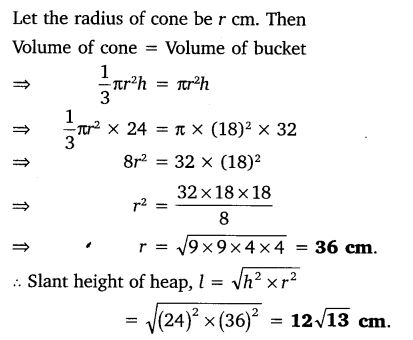
Ex 13.3 Class 10 Maths Question 8.
Water in a canal, 6 m wide and 1.5 m deep, is flowing with a speed of 10 km/h. How much area will it irrigate in 30 minutes, if 8 cm of standing water is needed?
Solution: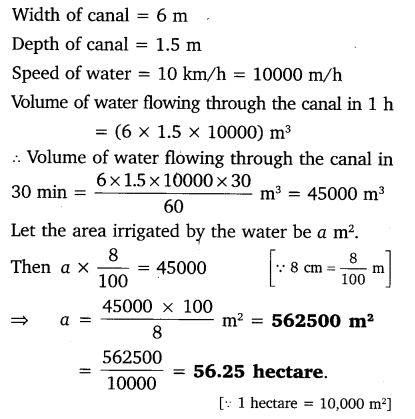
Ex 13.3 Class 10 Maths Question 9.
A farmer connects a pipe of internal diameter 20 cm from a canal into a cylindrical tank in her field, which is 10 m in diameter and 2 m deep. If water flows through the pipe at the rate of 3 km/h, in how much time will the tank be filled?
Solution: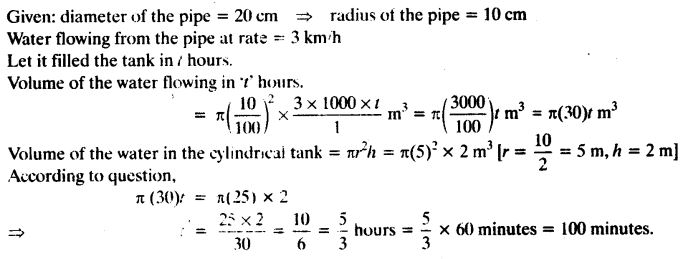
NCERT Solutions for Class 10 Maths Chapter 13 Surface Areas and Volumes (Hindi Medium) Ex 13.3
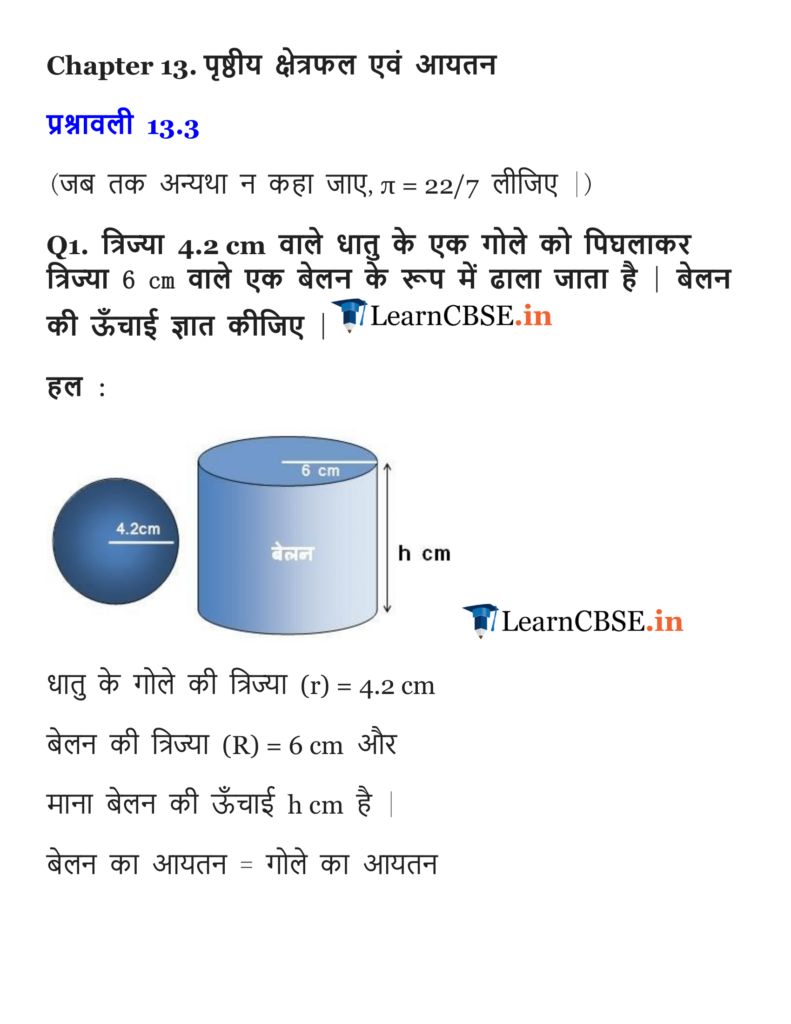
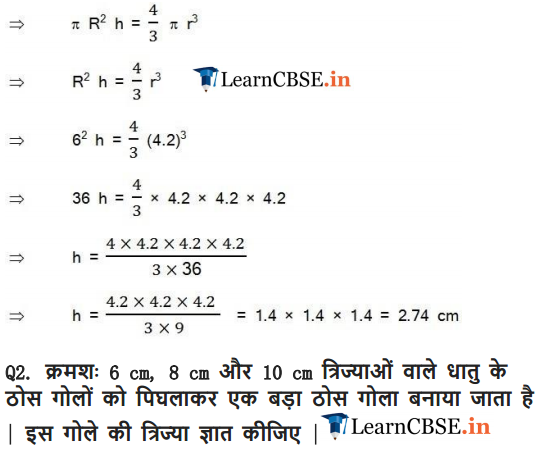
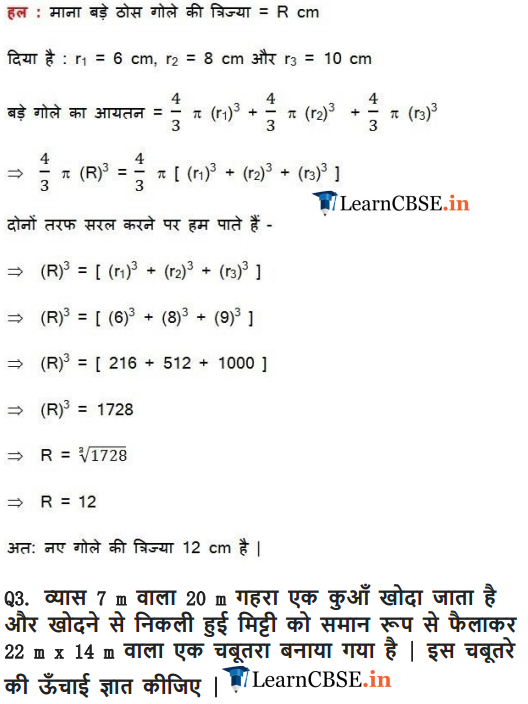
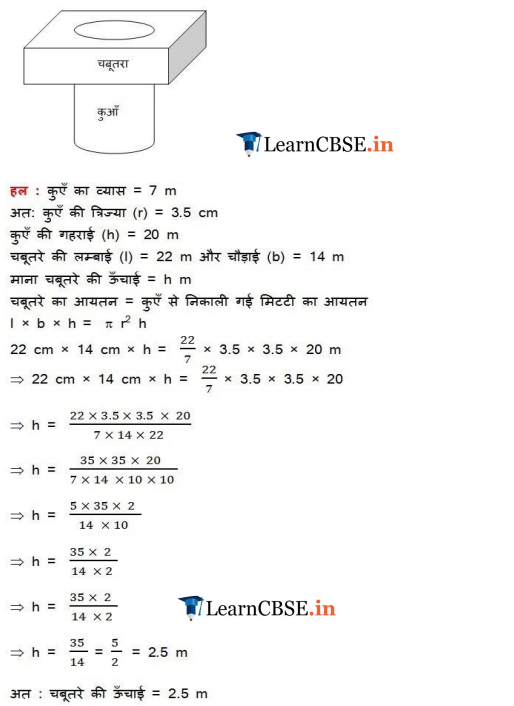
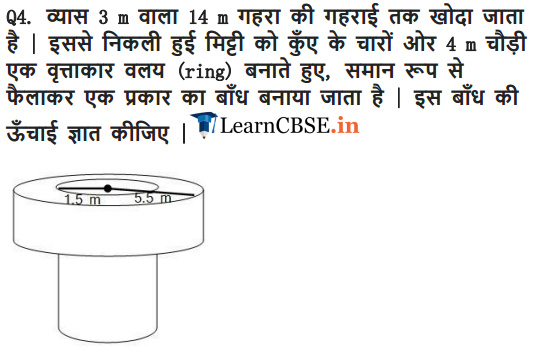
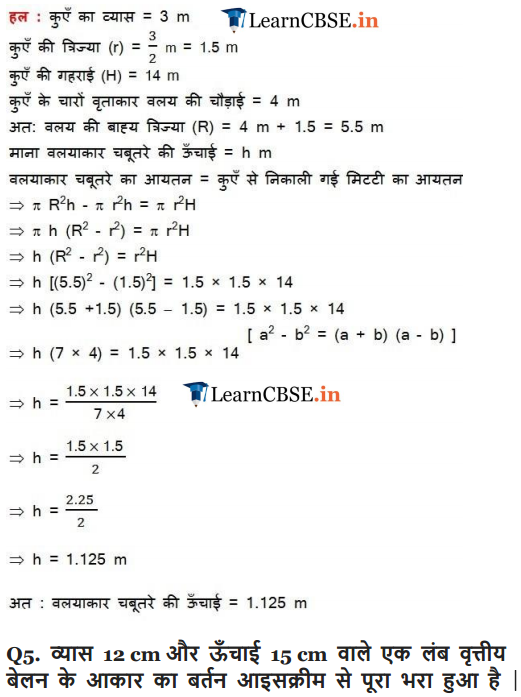
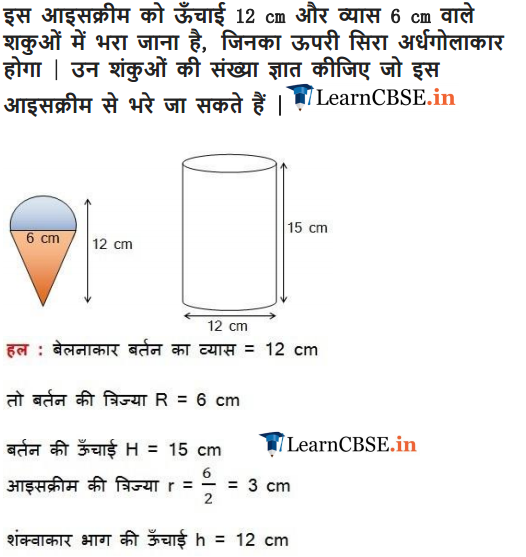
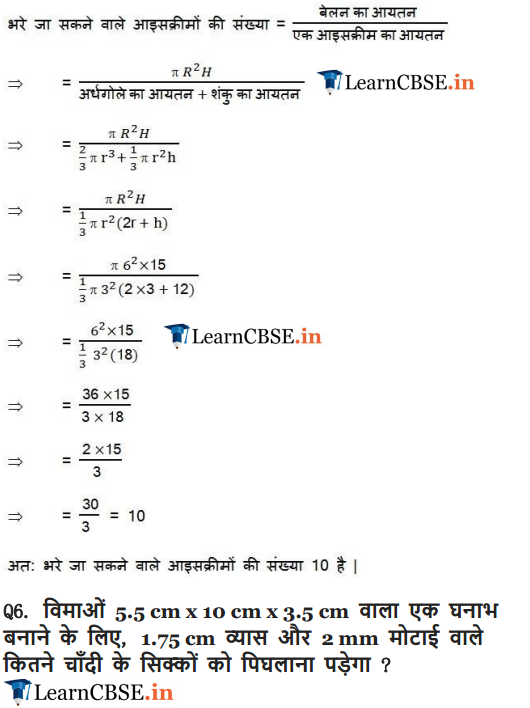
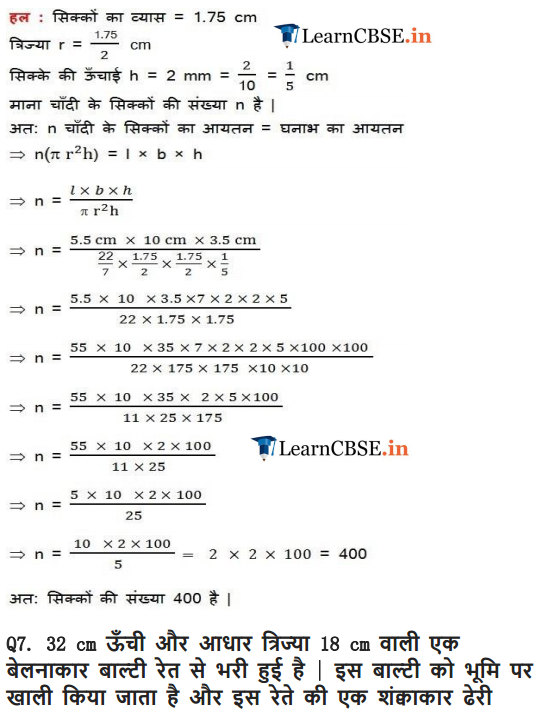
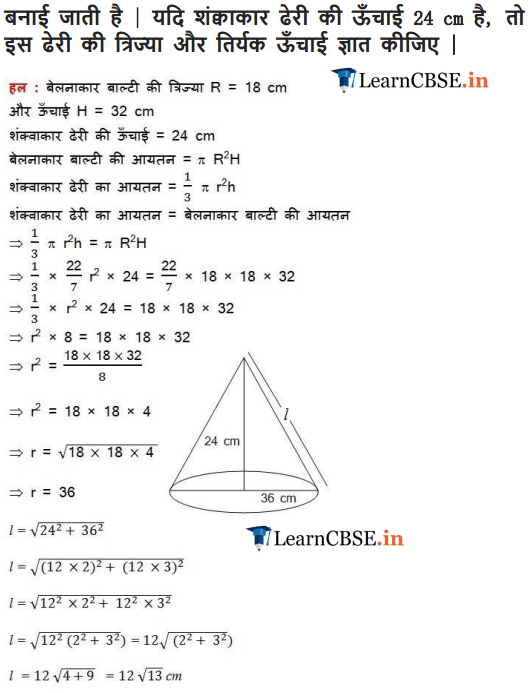
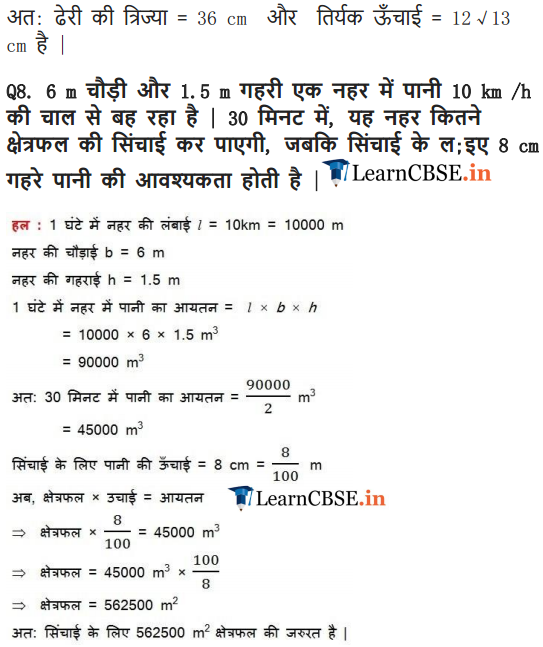
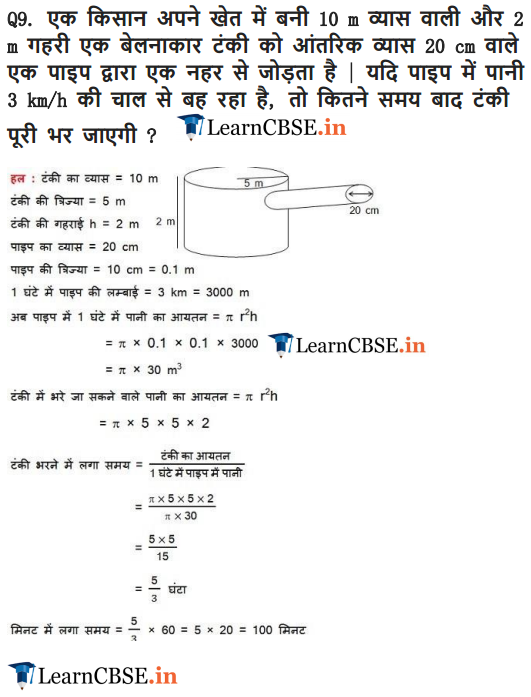
Class 10 Maths Chapter 13 Surface Areas and Volumes Ex 13.4
Ex 13.4 Class 10 Maths Question 1.
A drinking glass is in the shape of a frustum of a cone of height 14 cm. The diameters of its two circular ends are 4 cm and 2 cm. Find the capacity of the glass.
Solution:
Ex 13.4 Class 10 Maths Question 2.
The slant height of a frustum of a cone is 4 cm and the perimeters (circumference) of its circular ends are 18 cm and 6 cm. Find the curved surface area of the frustum.
Solution: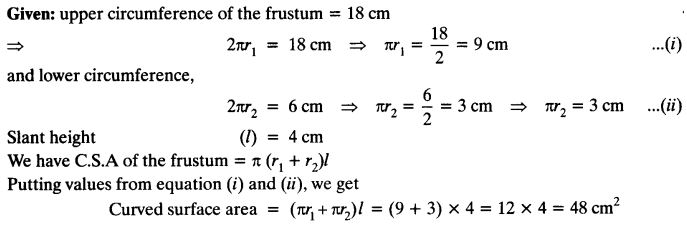
Ex 13.4 Class 10 Maths Question 3.
A fez, the cap used by the Turks, is shaped like the frustum of a cone. If its radius on the open side is 10 cm, radius at the upper base is 4 cm and its slant height is 15 cm, find the area of material used for making it.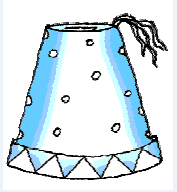
Solution: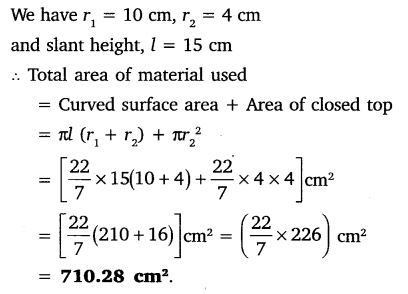
Ex 13.4 Class 10 Maths Question 4.
A container, opened from the top and made up of a metal sheet, is in the form of a frustum of a cone of height 16 cm with radii of its lower and upper ends as 8 cm and 20 cm, respectively. Find the cost of the milk which can completely fill the container, at the rate of Rs 20 per litre. Also find the cost of metal sheet used to make the container, if it costs Rs 8 per 100 cm2.
Solution: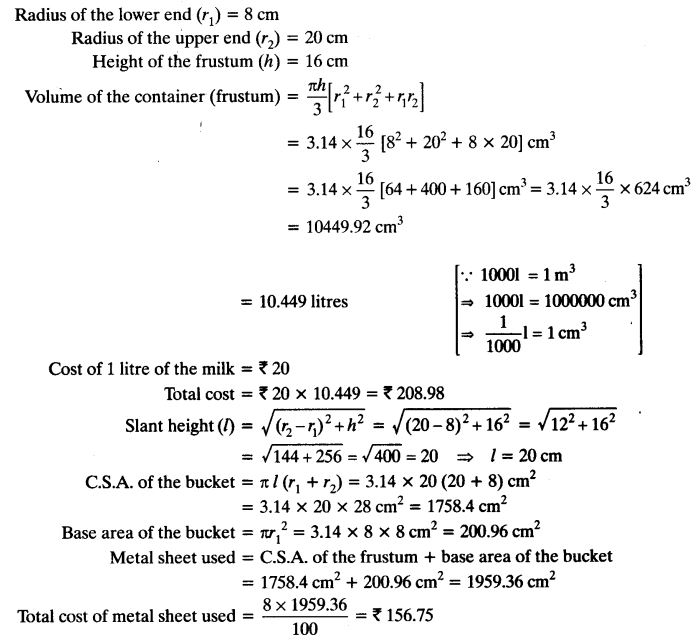
Ex 13.4 Class 10 Maths Question 5.
A metallic right circular cone 20 cm high and whose vertical angle is 60 is cut into two parts at the middle of its height by a plane parallel to its base. If the frustum so obtained be drawn into a wire of diameter 1/16 cm, find the length of the wire.
Solution: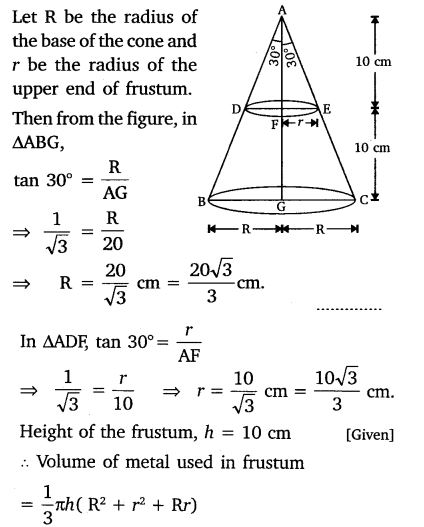
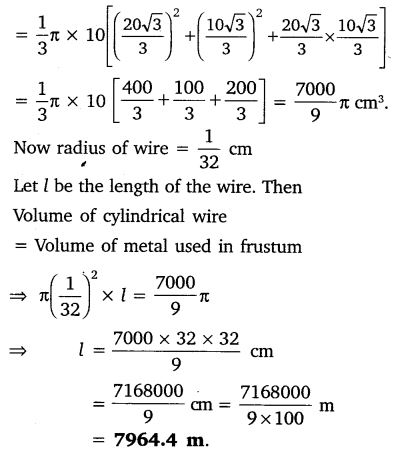
NCERT Solutions for Class 10 Maths Chapter 13 Surface Areas and Volumes (Hindi Medium) Ex 13.4
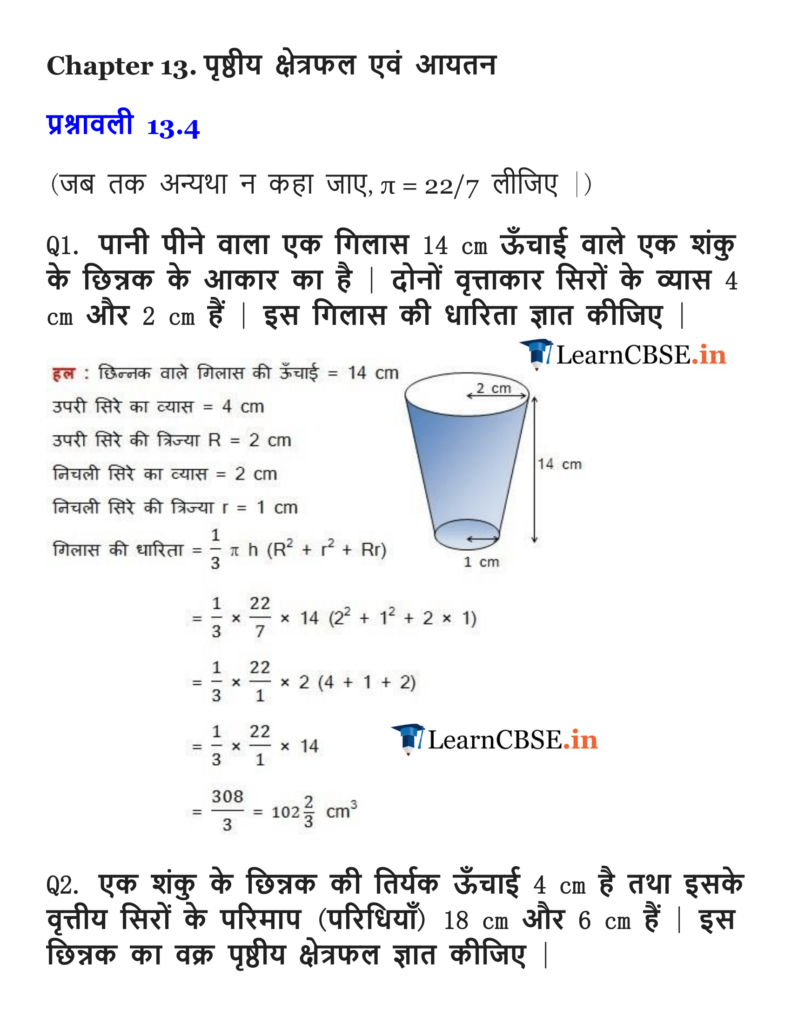
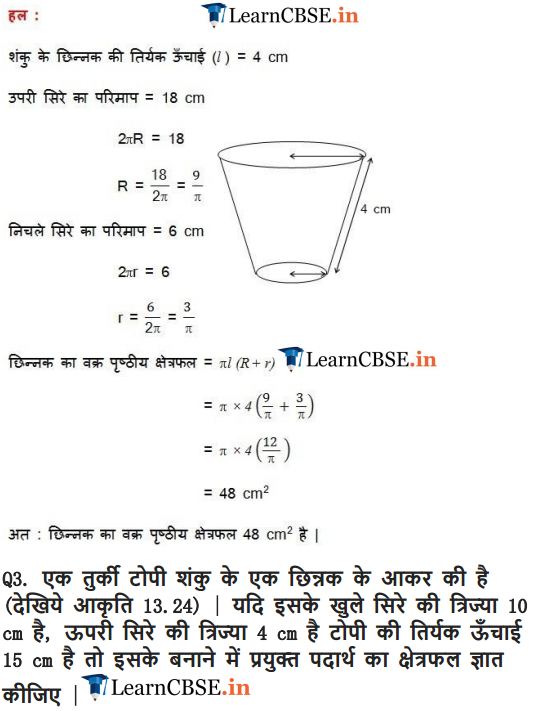
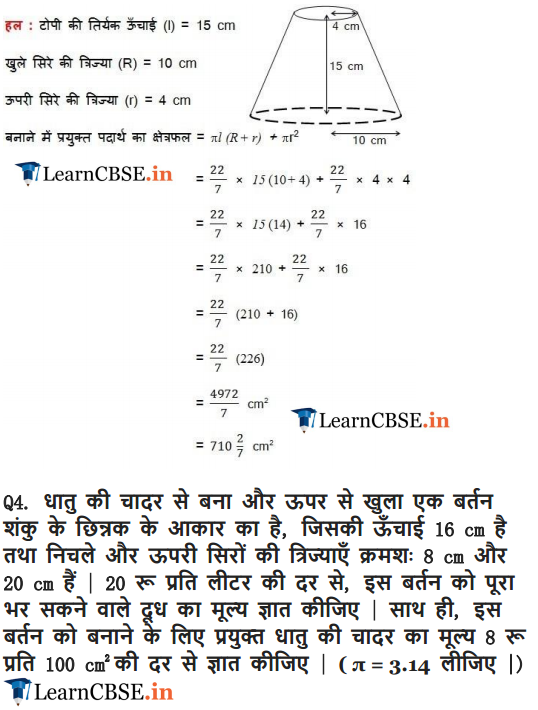
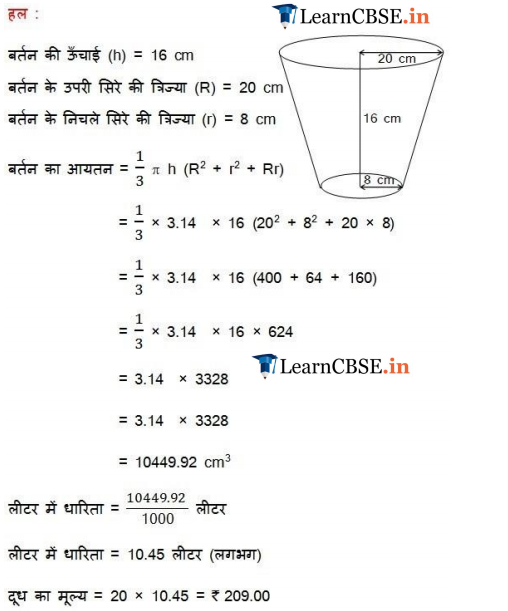
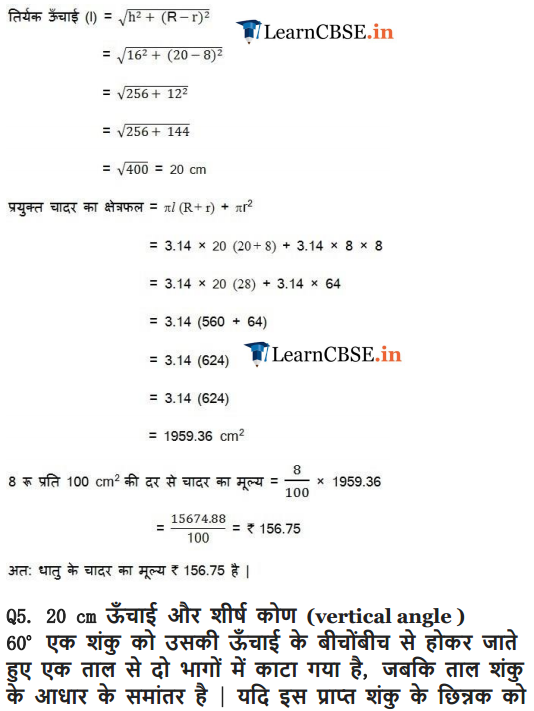
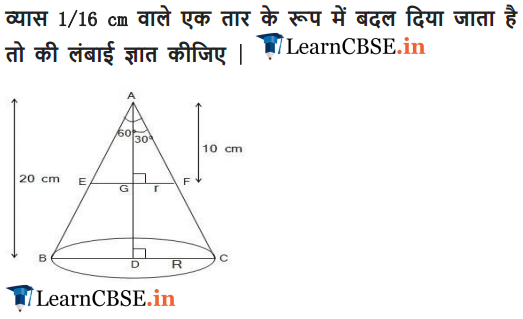
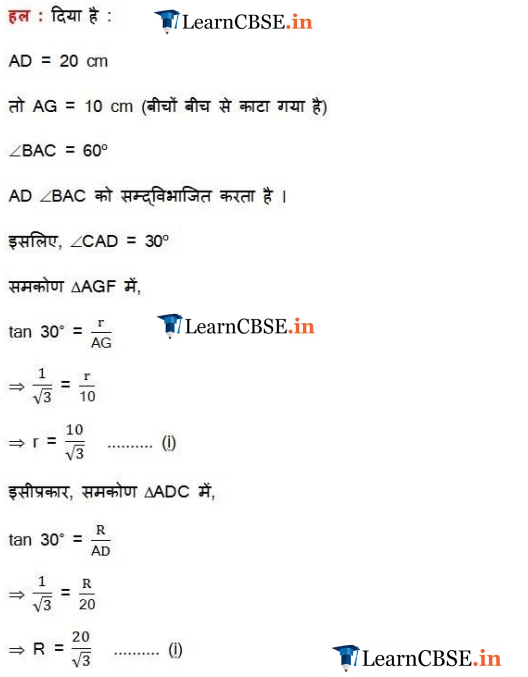
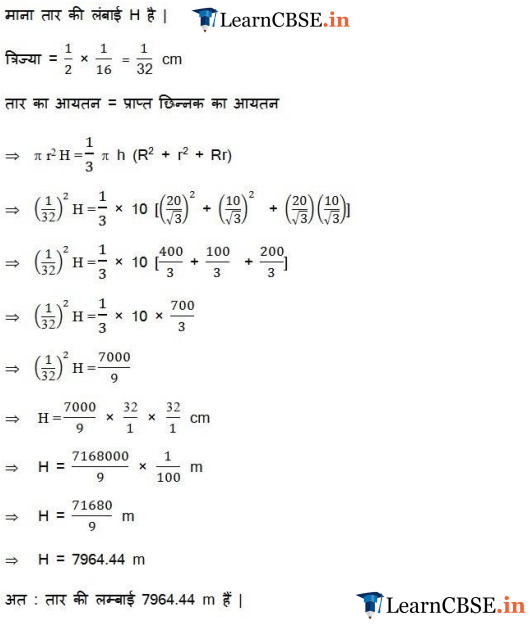
Class 10 Maths Chapter 13 Surface Areas and Volumes Ex 13.5
Ex 13.5 Class 10 Maths Question 1.
A copper wire, 3 mm in diameter is wound about a cylinder whose length is 12 cm, and diameter 10 cm, so as to cover the curved surface of the cylinder. Find the length and mass of the wire, assuming the density of copper to be 8.88 g per cm3.
Solution: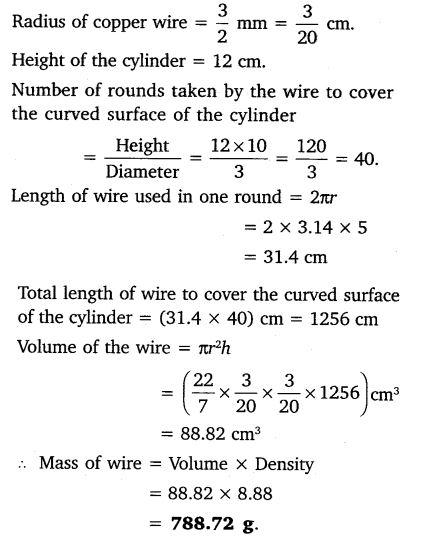
Ex 13.5 Class 10 Maths Question 2.
A right triangle, whose sides are 3 cm and 4 cm (other than hypotenuse) is made to revolve about its hypotenuse. Find the volume and surface area of the double cone so formed.
Solution: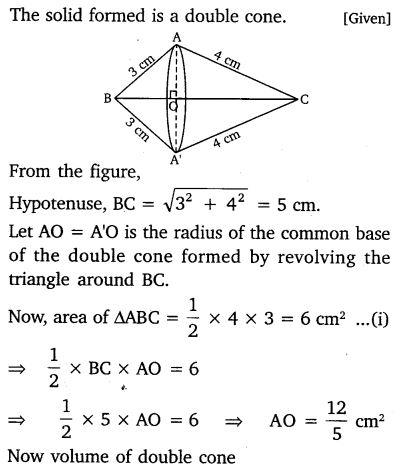
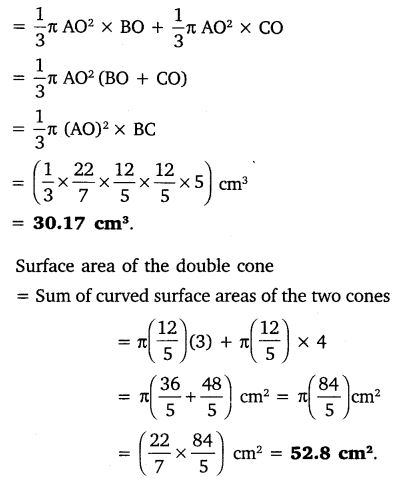
Download NCERT Solutions For Class 10 Maths Chapter 13 Surface Areas and Volumes PDF
Ex 13.5 Class 10 Maths Question 3.
A cistern measuring 150 cm x 120 cm x 110 cm has 129600 cm3 water in it. Porous bricks are placed in the water until the cistern is full to the brim. Each brick absorbs one seventeenth of its own volume of water. How many bricks can be put in without overflowing the water, each brick being 22.5 cm x 7.5 cm x 6.5 cm?
Solution: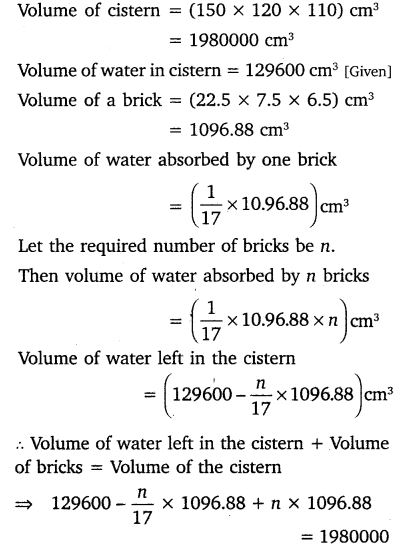
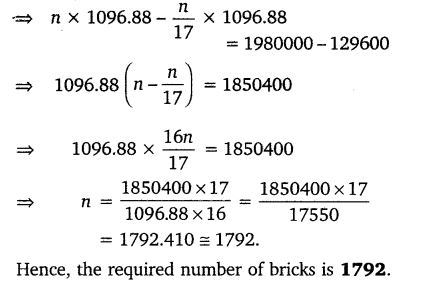
Ex 13.5 Class 10 Maths Question 4.
In one fortnight of a given month, there was a rainfall of 10 cm in a river valley. If the area of the valley is 7280 km, show that the total rainfall was approximately equivalent to addition to the normal water of three rivers each 1072 km long. 75 m wide and 3 m deep.
Solution: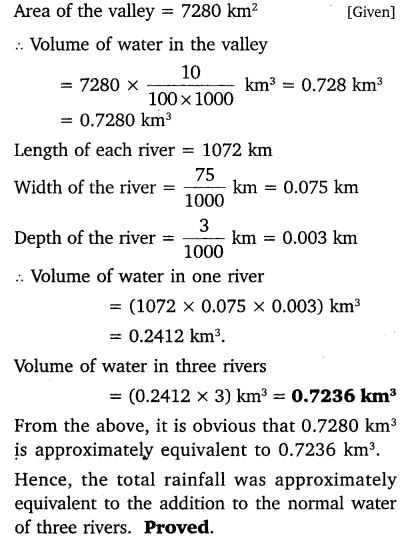
Ex 13.5 Class 10 Maths Question 5.
An oil funnel made of tin sheer consists of a 10 cm long cylindrical portion attached to a frustum of a cone. If the total height is 22 cm, diameter of the cylindrical portion is 8 cm and the diameter of the top of the funnel is 18 cm, find the area of the tin sheet required to make the funnel.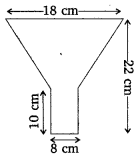
Solution: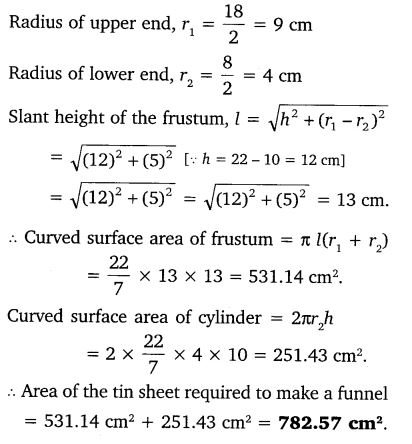
NCERT Solutions for Class 10 Maths Chapter 13 Surface Areas and Volumes (Hindi Medium) Ex 13.5
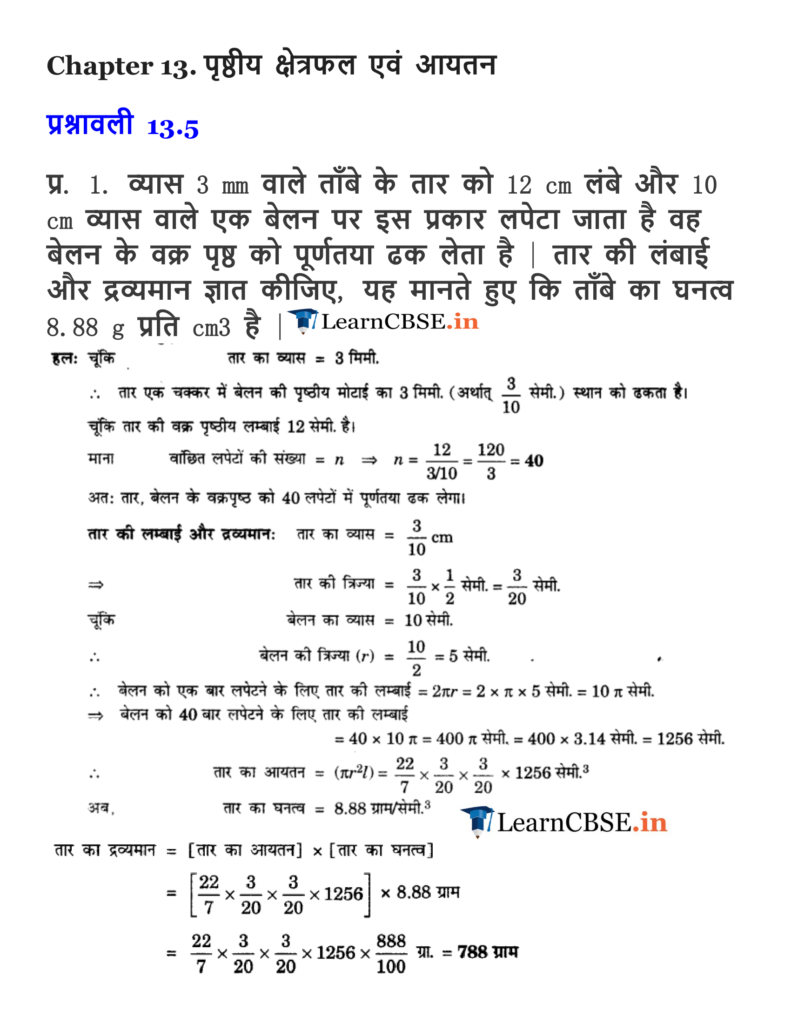
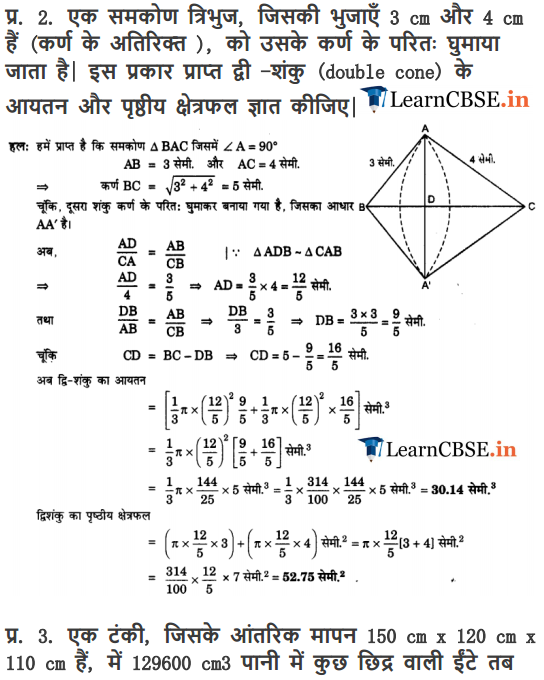
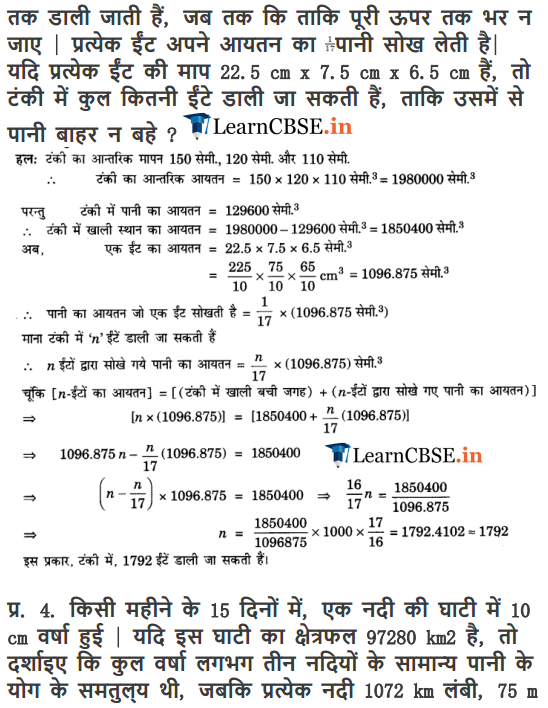
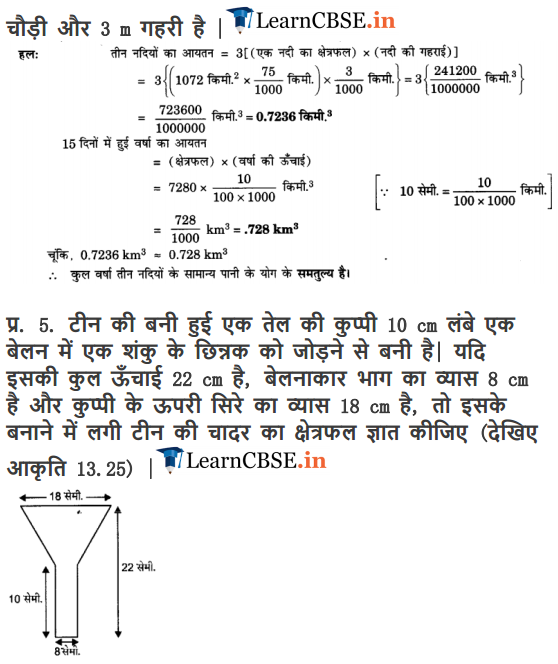
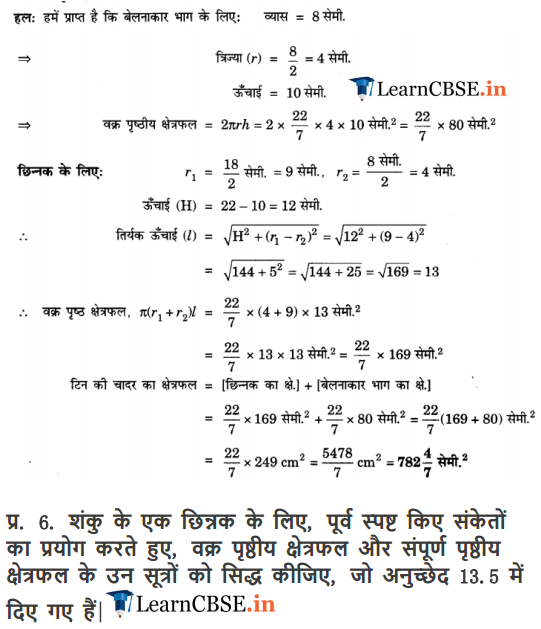
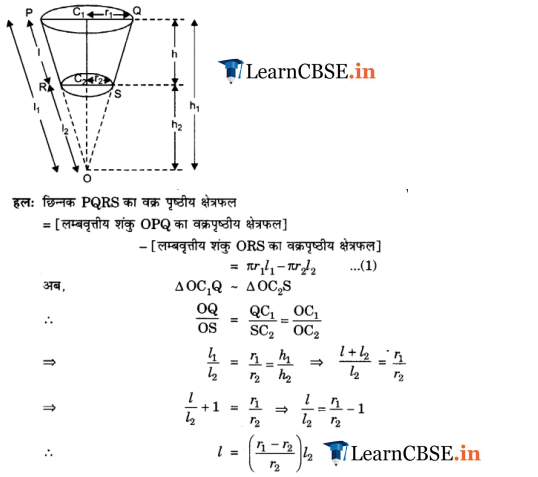
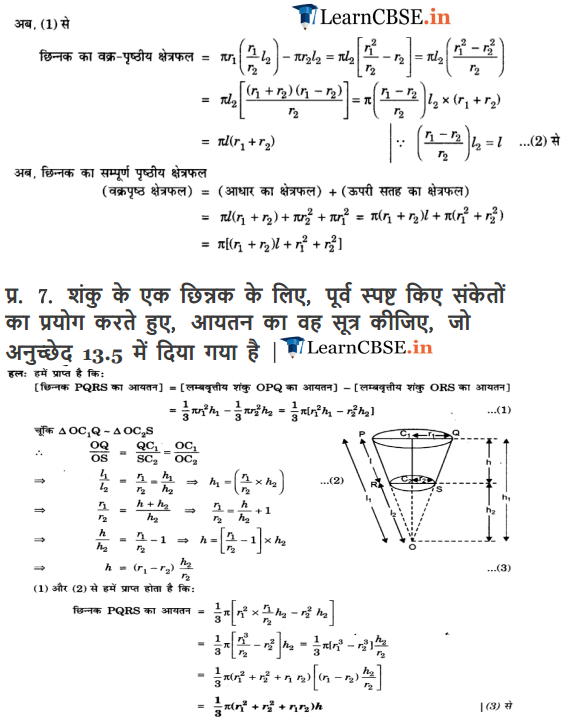
Surface Areas and Volumes Class 10 Extra Questions Very Short Answer Type
Question 1.
Vol. and surface area of a solid hemisphere are numerically equal. What is diameter of hemisphere ? [CBSE Delhi 2017]
Answer:
Vol. of hemisphere = S. A. of solid hemisphere 2 ,
⇒
⇒ r =
∴ diameter = 2r = 9 units
Question 2.
If the ratio of volume of two spheres is 1 : 8, then find the ratio of their surface area.
Answer: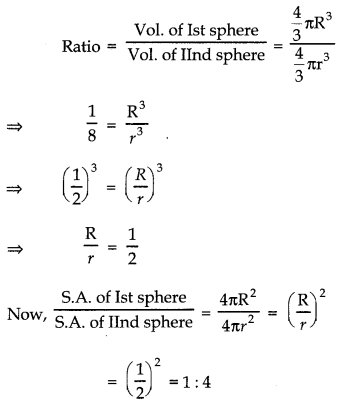
Question 3.
A solid sphere of radius r is melted and recast into the shape of a solid cone of height r. Find the radius of the base of the cone.
Answer: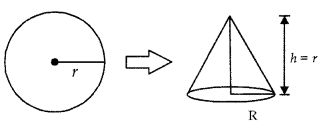
According to question,
Vol. of sphere = Vol. of cone
⇒
⇒
⇒ R2 = 4r2
∴ R = 2r
Question 4.
The diameter of sphere is 6 cm. It is melted and drawn into a wire of radius 1 mm. Find the length of wire.
Answer:
Radius of sphere (R) = 3 cm = 30 mm
Radius of wire (r) = 1 mm
Volume of sphere = Volume of wire
36000 mm = l
l = 3600 cm
Question 5.
A metallic spherical shell of internal and external diameters 4 cm and 8 cm respectively is melted and recast into the form of a cone of base diameter 8 cm. Find height of the cone.
Answer:
Internal radius (r) =
External radius (R) =
Radius of cone (r1) =
Height of cone = h
Outer volume – Inner volume = Volume of cone
⇒
⇒ 4[R3 – r3] = r12h
⇒ 4[43 – 23] = (4)2h
⇒ 4[64 – 8] = 16 h
⇒
∴ h = 14 cm
Question 6.
If the area of the surface of sphere is 4π cm. Find the diameter of the sphere.
Answer:
Surface area of sphere = 4π
4πr2 = 4π
r = 1
∴ Diameter = 2r = 2 × 1 = 2 cm
Question 7.
Find the volume and surf ace area of the largest cube that can be carved out of solid wooden sphere of radius 6√3 cm.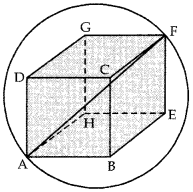
Answer:
For the largest cube (say ABCDEFGH) the diagonal of the cube (AF) must be along the diameter of the given sphere.
Length of diagonal of cube (AF)
= 2r = 2 × 6√3 = 12√3
If edge of the cube is a cm,
then diagonal AF= √3a
⇒ √3a = 12√3 ⇒ a = 12
∴ Volume of required cube
= a3 = (12)3 = 1728 cm3
Surface area of cube = 6a2 = 6 × (12)2
= 864 cm2
Surface Areas and Volumes Class 10 Extra Questions Short Answer Type-1
Question 1.
Two cubes each of volume 64 cm3 are joined end to end. Find the surface area of the resulting cuboid.
Answer:
Let edge of the each cube be a cm.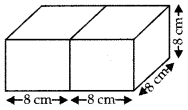
⇒ a3 = 64
⇒ a3 = (8)3
⇒ a = 8 cm
When two cubes are joined,
length of cuboid (1) = 2a = 2 × 8 = 16 cm
breadth (b) = a = 8 cm
height (h) = a = 8 cm
∴ Surface area of cuboid = 2 (lb + bh + Ih)
= 2 (16 × 8 + 8 × 8 + 16 × 8)
= 2 (128 + 64 + 128)
= 2 × 320
= 640 cm2
Question 2.
Find the length of the longest rod that can be kept in a room of dimensions 12 cm × 9 cm × 8 cm.
Answer:
Clearly, the longest rod can be kept only along the diagonal of cuboidal room.
∴ Length of the longest rod = Diagonal of cuboid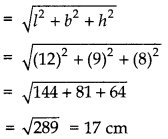
Question 3.
Find the volume of the largest right circular cone that can be cut out of a cube whose edge is 8 cm.
Answer:
For largest volume, the base of cone must be an inscribed circle in the face of the cube.
Diameter of base = Edge of cube = 8 cm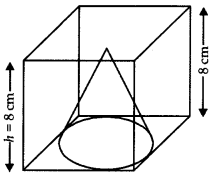
Radius (r) =
and height of cone (h) = Edge of cone = 8 cm
Hence, volume of the largest cone =
=
Question 4.
A rectangular sheet of paper is 22 cm long and 12 cm wide. A cylinder is formed by rolling the paper along its length. Find the volume of cylinder.
Answer:
As illustrated in figure length (22 cm) of paper will become circumference of the base of cylinder and breadth of paper will become height of cylinder.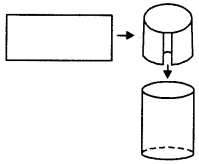
∴ 2πr = 22
⇒ r =
Thus, volume of cylinder = πr2h
= π
=
Question 5.
A toy is in the form of a cone mounted on a hemisphere of common base of radius 7 cm. The total height of the toy is 31 cm. Find the total surface area of the toy. [take π =
Answer:
Here, height of cone (h)
= Total height – Radius of hemisphere
= 31 – 7 = 24cm
im-9
Radius (r) = 7 cm
l =
=
Total surface area = Lateral surface area of hemisphere + Lateral surface area of cone
= 2π2 + πrl = πr (2r + l)
=
= 22 × 39
= 858 cm2
Question 6.
The decorative block shown in fig. is made of two solids-a cube and a hemisphere. The base of the block is a cube with edge 5 cm and the hemisphere fixed on the-top has a diameter of 4.2 cm. Find the total surface area of the block. [take π = 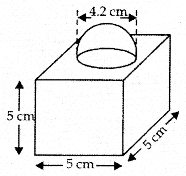
Answer:
Edge of cube (a) = 5 cm
∴ Total surface area of cube = 6a2
= 6(5)2 = 150 cm2
Radius of hemisphere (r) =
Surface area of block = {Total surface area of cube + Curved surface area of hemisphere} – base area of hemisphere
= {150 + 2πr2} – πr2 = 150 + πr2
= 150 +
= 150 + 13.86 = 163.86 cm2
Question 7.
A circus tent is cylindrical to a height of 3 m and conical above it. If its base radius is 52.5 m and slant height of the conical portion is 53 m, find the area of the canvas needed tomake the tent. [Use π =
Answer:
Here radius (r) = 52.5 m
Height of cylinder (h) = 3 m
Slant height of cone (l) = 53 m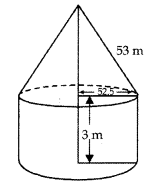
Area of canvas = Curved surface area of cylinder + Lateral surface area of cone
= 2πrh + πrl = πr(2h + l)
=
= 22 × 7.5 × 59
= 9735 m2
Surface Areas and Volumes Class 10 Extra Questions Short Answer Type-2
Question 1.
A hemispherical tank full of water is emptied by a pipe at the rate of 3
Answer:
Tank is in the form of hemisphere with
Diameter = 3 m
So, radius r =
Volume of the tank = 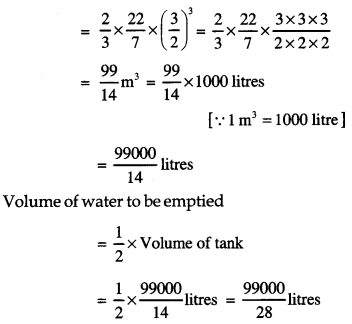
Now, it is given that,
tank is emptied at 3
Time taken to empty
Time taken to empty 1 litre = 1 ×
Time taken to empty
=
Question 2.
The
Answer: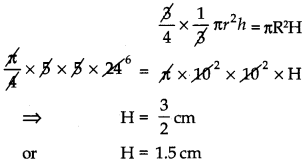
Question 3.
A metallic solid sphere of radius 10.5 cm is melted and recasted into smaller solid cones, each of radius 3.5 cm and height 3 cm. How many cones will be made? [CBSE 2017]
Answer:
Let the number of cones be n
Volume of solid sphere = Volume of ‘n’ solid cones
⇒
= n ×
⇒ n =
∴ n = 126.
Question 4.
In figure, a tent is in the shape of a cylinder surmounted by a conical top of same diameter. If the height and diameter of cylindrical part are 2.1 m and 3 m respectively and the slant height of conical part is 2.8 m, find the cost of canvas needed to make the tent if the canvas is available at the rate of ₹ 500/sq. metre. (Use π = 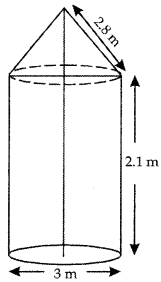
Answer:
Area of canvas = 2πrh + πrl = πr (2h + l)
=
=
Cost @ ₹ 500/m2 = 33 × 500 = ₹ 16500
Question 5.
The radii of the circular ends of a bucket of height 15 cm are 14 cm and r cm (r < 14 cm). If the volume of bucket is 5390 cm3. Find the value of r. [Use π =
Answer:
Here, h = 15 cm
R = 14 cm
r = ?
Volume of bucket (frustum)
= 5390 cm3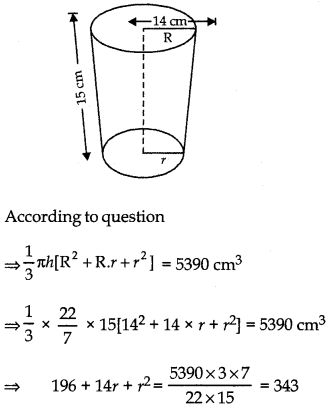
⇒ r2 + 21r – 7r – 147 = 0
⇒ r(r + 21) -7 (r + 21) = 0
⇒ (r – 7)(r + 21) = 0
⇒ r = 7 cm
or r = -21 cm
∵ Radius cannot be (-ve)
∴ r =7 cm
Question 6.
How many coins 1.75 cm in diameter and of ) thickness 2 mm must be melted to form a cuboid of dimensions 11 cm × 10 cm × 7 cm?
Answer:
Let the radius and thickness of each coin be r and h respectively.
Then, r =
h = 2 mm =
Vol. of each coin = πr2h
[
For cuboid:
l = 11 cm, b = 10 cm and h = 7cm
∴ Volume of cuboid = l × b × h
= (11 × 10 × 7) cm3.
∴ Required no. of coins to be melted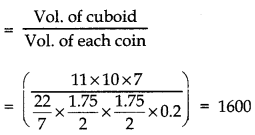
Question 7.
The cost of painting the total outer surface of a closed cylindrical oil tank at 60 paise per sq. cm is ₹ 237.60. The height of the tank is 6 times the radius of the base of the tank. Find height and radius of the tank. [Use π =
Answer:
Total cost of painting = ₹ 237.60
Rate of painting ₹ 0.60 per cm2.
∴ Total surface area
= 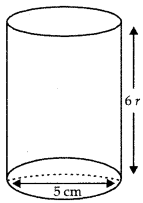
According to question,
∵ 2πr (r + h) = 396 cm2
⇒ 2 ×
⇒ 2 ×
⇒ 44r2 = 396 cm2
⇒ r2 =
⇒ r = √9cm = 3cm
Hence, h = 6r = 6 × 3 = 18 cm
Height = 18 cm;
radius = 3 cm
Question 8.
A cone of maximum size is curved out from a cube of edge 14 cm. Find the surf ace area of the remaining solid after the cone is curved out. [CBSE Sample Paper-2017-18]
Answer:
Radius of cone =
Height of cone = edge of cube = 14 cm
∴ Using Pythagoras Theorem:
l =
=
Surface area of remaining solid
= S.A. of cube – S.A. of circular base of cone + Lateral S.A. of cone
= 6a2 – πr2 + πrl
where a → edge of cube
r → radius & l → slant height of cone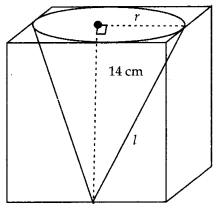
= 6 × 14 × 14 –
= 1176 – 154 + 154√3
= (1022 + 154√5) cm2
Question 9.
A conical vessel, with base radius 5 cm and height 24 cm, is full of water. This water is emptied into a cylindrical vessel of base radius 10 cm. Find the height to which the water will rise in the cylindrical vessel. [Use π =
Answer:
Vol. of water in conical vessel = Vol. of water in cylinder vessel
⇒
⇒
⇒ H = 2 cm
So water will rise by 2 cm in cylindrical vessel.
Question 10.
A sphere of diameter 12 cm, is dropped in a right circular cylindrical vessel, partly filled with water. If the sphere is completely submerged in water, the water level in the cylindrical vessel rises by 3
Answer:
Vol. of sphere =Vol. of water raised in cylinder
⇒
⇒
⇒ r = 9
⇒ Diameter d = 2r = 2 × 9 = 18 cm
Question 11.
The sum of the radius of base and height of a solid right circular cylinder is 37 cm. If the total surface area of the solid cylinder is 1628 sq. cm, find the volume of the cylinder. [Use π =
Answer:
Let the radius of base and height of the solid right circular cylinder be r cm and h cm, respectively. According to the question,
r + h = 37 …(1)
Total surface area = 1628 sq cm
2πr(r + h) = 1628 …(2)
From (1) and (2), we get
2πr(37) = 1628
⇒ r =
⇒ r = 7 cm
Substituting the value of r in (1), we get
7 + h = 37
⇒ h = 30 cm
Now,
Volume of the cylinder = πr2h =
Hence the volume of the cylinder is 4,620 cm3.
Surface Areas and Volumes Class 10 Extra Questions Long Answer Type 1
Question 1.
A copper rod of diameter 1 cm and length 8 cm is drawn in to a wire of length 18 m of uniform thickness. Find the thickness of wire.
Or
A metallic sphere of radius 4.2 cm is melted and recast into the shape of a cylinder of radius 6 cm. Find the height of the cylinder. [CBSE SQP 2019 (Basic)]
Answer:
Radius of copper rod, (r) =
Length of copper rod, (h) = 8 cm
Let ‘t’ cm be thickness of wire into which rod is to be drawn.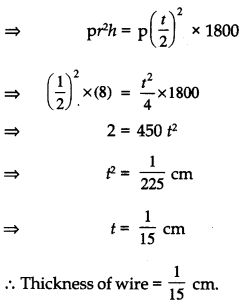
Or
Radius of sphere (r) = 4.2 cm
Radius of cylinder (R) = 6 cm
Let height of cylinder be H cm
Then, volume of sphere = volume of cylinder
⇒
⇒
⇒ H =
= 2.744 cm
∴ Height of cylinder is 2.744 cm.
Question 2.
A bucket open at the top is in the form of a frustum of a cone with a capacity of 12308.8 cm3. The radii of the top and bottom of circular ends of the bucket are 20 cm and 12 cm respectively. Find the height of the bucket and also the area of the metal sheet used in making it. (Use π = 3.14). [CBSE 2019]
Answer:
Volume of the bucket = 12308.8 cm3
Let R = 20 cm, r = 12 cm
∴ V =
∴ 12308.8 =
h =
Now, l2 = h2 + (R – r)2
= (15)2 + (20 – 12)2
= 225 + 64 = 289
⇒ l = 17 cm
Surface area of metal sheet used
= πr2 + πl(R – r)
π[r2 + l(R + r)] = 3.14(144 + 17 × 32)
= 2160.32 cm2
Question 3.
The height of a cone is 10 cm. The cone is divided into two parts using a plane parallel to its base at the middle of its height. Find the ratio of the volumes of the two parts. [CBSE Delhi 2017]
Answer:
Let r1 r2 be radii of smaller & larger part of cone with h1 = 5cm, h2 = 10 cm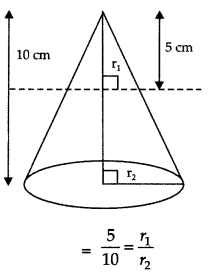
⇒ r2 = 2r1
Ratio of volumes of two parts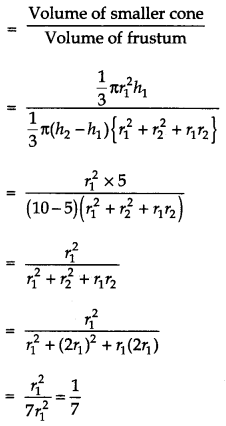
Reqd.Ratio = 1: 7
Question 4.
In a hospital used water is collected in a cylindrical tank of diameter 2 m and height 5 m. After recycling, this water is used to irrigate a park of hospital whose length is 25 m and breadth is 20 m. If tank is filled completely then what will be the height of standing water used for irrigating the park. Write your views on recycling of water. [CBSE 2017]
Answer:
Radius (R) of cylindrical tank =
=
height (H) of cylindrical tank = 5 m
Let h be height of standing water in park of (l) length 25 m and (b) breadth = 20 m
Volume of water in cylindrical tank
= Volume of water in park ⇒ πr2H = l × b × h
= 
Question 5.
The height of a cone is 30 cm. From its topside a small cone is cut by a plane parallel to its base. If volume of smaller cone is
Answer:
Let plane parallel to the base passes through BC
let AB = h, B = r1 cm, PQ = r2 cm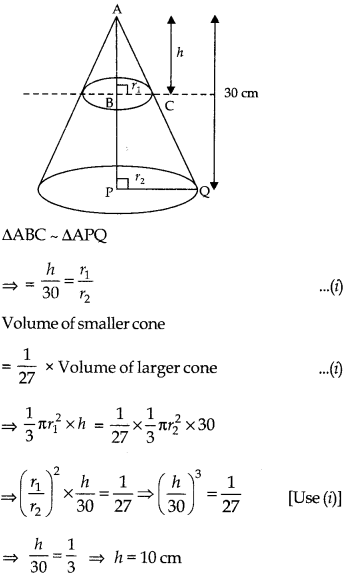
Question 6.
An elastic belt is placed around the rim of a pulley of radius 5 cm. (figure). From one point C on the belt, the elastic belt is pulled directly away from the centre O of the pulley until it is P, 10 cm from the point O. Find the length of the belt that is still in contact with the pulley. Also find the shaded area. (Use π = 3.14 and √3 = 1.73) [CBSE 2016]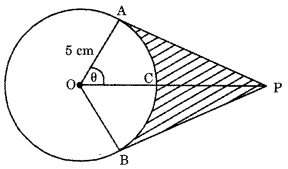
Answer:
Given OA = 5 cm
OP = 10 cm
We know that the tangent at any point of a circle is perpendicular to the radius through the point of contact.
Therefore, ΔOAP is a right-angled triangle.
∠OAP = 90°
Now, OP2 = CA2 + AP2
102 = 52 + AP2
AP2 = 75
AP = 5√3 cm
Also, cos θ =
⇒ cos θ =
⇒ θ = 60°
Now, ∠AOF = ∠BOP = 600 (∵ ΔOAP ≅ ΔOBP)
⇒ ∠AOB = 120°
Length of the belt still in contact with the pulley
= Circumference of the circle – Length of the arc ACB
= 2πr –
= 2 × 3.14 × 5 – 2 × 3.14 × 5 ×
= 2 × 3.14 × 5 × (1 –
= 2 × 3.14 × 5 ×
= 20.93 cm (Approx)
Now, Area of ΔOAP
=
Similarly, Area of ΔOBP =
∴ Area of ΔOAP + Area of ΔOBP = 25√3 cm2
= 25 x 1.73 = 43.25 cm2
Area of sector OACB =
=
∴ Area of the shaded region
= ( Area of ΔOAP + Area of ΔOBP) – (Area of the sector OACB
= 43.25 cm2 – 26.17 cm2)
= 17.08 cm2 (Approx.)
Question 7.
A wooden toy is in the shape of a cone T mounted on a cylinder, , 1 as shown in figure. The total height of the toy is 26 cm, while the height of the conical part is 6 cm. The diameter of the base of the conical part is 5 cm and that of cylindrical part is 4 cm. The conical part and the cylindrical part are respectively painted.red and white. Find the area to be painted by each of these colours. .
Answer:
For conical part:
Radius (R) =
Height (H) = 6 cm
Slant height (l) =
=
=
For cylindrical part:
Radius (r) = 2 cm
Height (h) = (26 – 6) = 20 cm
Now, area to be painted red = (Curved surface area of the cone) + (Base area of the cone) – (Base area of cylinder)
= πRl + πR2 – πr2
= π[Rl + R2 – r2]
=
=
=
=
Area to be painted white (Curved surface area of cylinder) + (Area of base of cylinder)
= 2πrh + πr2 = πr [2h + r]
=
=
= 264 cm2
Question 8.
A bucket made up of metal sheet is in the form of a frustum of a cone. Its depth is 24 cm and the diameters of the top and bottom are 30 cm and 10 cm respectively. Find the cost of milk which can completely fill the bucket at the rate of ₹ 20 per litre and the cost of the metal sheet used, if it costs ₹ 10 per 100 cm2. [Use π = 3.14]
Answer:
Here, depth (h) = 24 cm
Radius of top (R) =
Radius of bottom (r) = 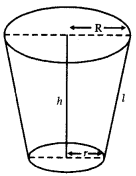
Slant height of frustum of cone
l =
=
=
= 26 cm
(i) Volume of the bucket = Volume of frustum of cone
=
=
= 3.14 × 8[225 + 25 + 75] = 8164 cm3
Quantity of milk =
Cost of 1 litre milk = ₹ 20
∴ Cost of 8.164 litre milk = 8.164 × 20
= ₹ 163.28
(ii) Total surface area of bucket (excluding the upper end)
= πl(R + r) + πr2
= 3.14 × 26 (15 + 5) + 3.14 × 52
= 1632.8 + 78.5
= 1711.3 cm2
Cost of 100 cm2 metal sheet = ₹ 10
∴ Cost of 1711.3 cm2 metal sheet
Question 9.
From a solid cylinder whose height is 2.4 cm and diameter 1.4 cm, a conical cavity of the same height and same diameter is hollowed out. Find the total surface area of the remaining solid.
Answer:
Here, height of cylinder = Height of cone = h = 2.4 cm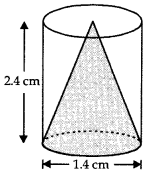
Radius of cylinder = Radius of base of cone = 1.4
r =
Slant height of conical part (l) =
=
=
Total surface area of remaining solid = Curved surface area of cylinder + Curved surface area of cone + Base area of cylinder.
= 2πrh + πrl + πr2 = πr [2h + l + r]
=
= 22 × 0.1 [4.8 + 3.2] = 2.2 × 8 = 17.6 cm2
Question 10.
From a solid cylinder of height 2.8 cm and diameter 4.2 cm a conical cavity of the same height and same diameter is hollowed out. Find tiie total surface area of the remaining solid. [Take π =
Answer: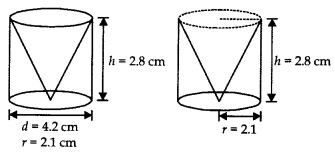
Radius of cone (r) = 2.1 cm, h = 2.8 cm
l =
=
Total surface area of solid = Curved surface area of cylinder + Area of base + Curved surface area of cone
= 2πrh + πr2 + πrl = πr(2h + r + l)
=
Question 11.
Due to heavy floods in a state, thousands were rendered homeless. 50 schools collectively offered to the state government to provide place and the canvas for 1500 tents to be fixed by the government and decided to share the whole expenditure equally. The lower part of each tent is cylindrical of base radius 2.8 m and height 3.5 m, with conical upper part of same base radius but of height 2.1 m. If the canvas used to make the tents costs ₹ 120 per sq. m, find the amount shared by each school to set up the tents. What value is generated by the above problem? [Use π =
Answer: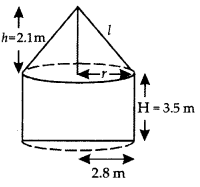
Slant height of cone (l) =
=
Amount of canvas required
= C.S.A. of cylinder + C.S.A. of cone
= 2πrH + πrl = πr(2H + l)
=
= 22 × 0.4 (10.5)
= 92.4 m2
Cost of entire canvas @ ₹ 120 per m2
= 92.4 × 120 = ₹ 11088
Share of each school =
= ₹ 221.76
Value of generosity, co-operation is generated out of this.
Surface Areas and Volumes Class 10 Extra Questions HOTS
Question 1.
A conical vessel of radius 6 cm and height 8 cm is completely filled with water. A sphere is lowered into the water and its size is such that when it touches the sides it is just immersed as shown in figure. What fraction of water flows out?
Answer:
Let r be the radius of sphere.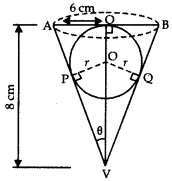
In right angled triangle AOV,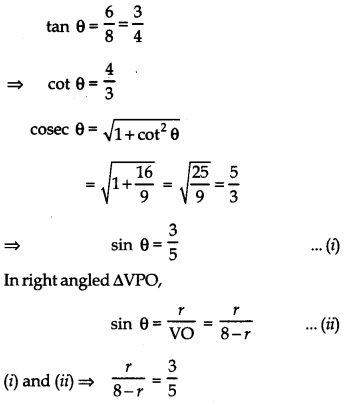
⇒ 5r = 24 – 3r
⇒ 8r = 24
⇒ r = 3 cm
∴ Volume of sphere =
Fraction of water that overflows
=
=
Question 2.
A vessel in shape of an inverted cone is surmounted by a cylinder has a common radius of 7 cm. It was filled with liquid till it covered one third the height of the cylinder. If the height of each part is 9 cm and the vessel is turned upside down. Find the volume of the liquid and to what height will it reach in the cylindrical part.
Answer:
Here,
radius of cylinder = radius of cone (r) = 7 cm
Height of cone (h1) = 9 cm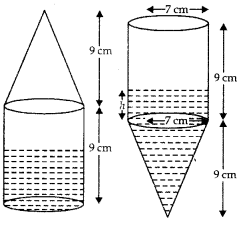
Let ‘h’ be height of water column in cylinder then according to as given
h =
Volume of liquid in vessel = Volume of liquid in cone + Volume of liquid in cylinder to a height of 3 cm
=
=
= π[147 + 147]
=
On turning upside down this 924 cm3 of liquid is poured in cylinder.
Let ‘H’ cm be the height to which liquid reaches in cylindrical vessel.
⇒ Volume of liquid column of height ‘H’ cm in cylinder = 924 cm3
⇒ π × (7)2 × H = 924
⇒ H =
Question 3.
The height of the cone is 30 cm. A small cone! is cut off at the top by a plane parallel to the base. If its volume be
Answer:
Small cone ADE be cut off at the top by the plane DE parallel to base BC.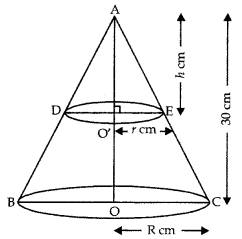
Let r, h be radius and height of small cone ADE. Also, R be the radius of larger cone.
Since ΔAO’E ~ ΔAOC,
∴
or
or r =
According to question,
Volume of smaller cone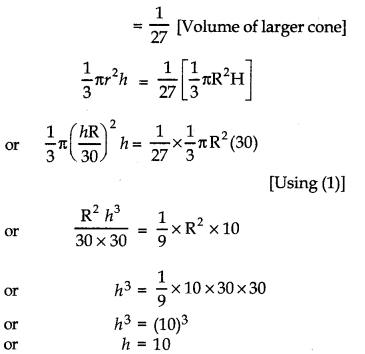
Question 4.
A tnilk tanker cylindrical in shape having ; diameters of 2 m and length 4.2 m supplies milk to the two booths in ratio of 3:2. One of the milk booths has a rectangular vessel having base area, 3.96 m2 and other has cylindrical vessel having diameter 2 m. Find the level of milk in each of the vessel.
Answer:
Diameter of cylindrical milk tanker = 2 m
Radius of cylindrical milk tanker = 1 m
Length (height) of cylindrical milk tanker = 4.2 m
Volume of the tanker = πr2h
=
According to question,
[Volume of rectangular vessel]: [Volume of cylindrical vessel]
= 3:2
Volume of rectangular vessel
= (
= 7.92 m3
and Volume of cylindrical vessel
= (
= 5.28 m3
According to 1st condition,
Volume of rectangular vessel = 7.92 m3
or Area of base × Height = 7.92
or 3.96 × Height = 7.92
or Height =
According to 2nd condition,
Diameter of cylindrical vessel = 2 m
Radius of cylindrical vessel =
Volume of cylindrical vessel = 5.28 m3
πr2h = 5.28
or
or h =
Hence, height of rectangular vessel and cylindrical vessel are 2 m and 1.68 m respectively.
Multiple Choice Questions
Choose the correct option for each of the following:
Question 1.
The volume of the largest circular cone that can be cut out from a cube of edge 4.2 cm is:
(a) 9.7 cm3
(b) 77.6 cm3
(c) 58.2 cm3
(d) 19.4 cm3
Answer:
(d) 19.4 cm3
Question 2.
The curved surface area of a right circular cone of height 15 cm and base diameter 16 cm is :
(a) 60 p cm2
(b) 68 p cm2
(c) 120 p cm2
(d) 136 p cm2
Answer:
(d) 136 p cm2
Question 3.
If the radii of circular ends of a frustum of a cone are 20 cm and 12 cm and its height is 6 cm, then the slant height of frustum (in cm) is:
(a) 10
(b) 8
(c) 12
(d) 15
Answer:
(a) 10
Question 4.
The radius of the base of a cylinder is doubled and the height remains unchanged, its curved surface area becomes:
(a) double
(b) three times
(c) half
(d) no change
Answer:
(a) double
Question 5.
If the surface area of a sphere is 144 p cm2, then its radius is:
(a) 6 cm
(b) 8 cm
(c) 12 cm
(d) 10 cm
Answer:
(a) 6 cm
Question 6.
A solid sphere of radius V is melted and recast into the shape of a solid cone of height V, then the radius of the base of the cone is:
(a) r
(b) 2r
(c) r2
(d)
Answer:
(b) 2r
Question 7.
A metallic cube of edge 1 cm is drawn into a wire of diameter 4 mm, then the length of the wire is:
(a) 8:9
(b) 9:8
(c) 5:7
(d) 7:5
Answer:
(c) 5:7
Question 8.
A solid sphere of radius x cm is melted and cast into a shape of a solid cone of radius x cm. Then the height of the cone is:
(a) 3x cm
(b) x cm
(c) 4x cm
(d) 2x cm
Answer:
(c) 4x cm
Question 9.
The radii of bases of cylinder and a cone are in the ratio 3 : 4 and their heights are in the ratio 2:3 then ratio between the volume of cylinder to volume of cone is:
(a) 8: 9
(b) 9 : 8
(c) 5 : 7
(d) 7: 5
Answer:
(b) 9 : 8
Question 10.
If a cone is cut into two parts by a horizontal plane passing through the mid points of its axis, the ratio of the volumes of the upper part and the cone is :
(a) 1:2
(b) 1:4
(c) 1:6
(d) 1:8
Answer:
(d) 1:8
Question 11.
A hollow cube of internal edge 22 cm is filled with spherical marbles of diameter 0.5 cm and it is assumed that
(a) 142296
(b) 142396
(c) 142496
(d) 142596
Answer:
(a) 142296
Question 12.
The diameter of a metallic sphere is 6 cm. It is melted and drawn into a wire of diameter 2 cm, then the length of the wire is:
(a) 12 cm
(b) 18 cm
(c) 36 cm
(d) 66 cm
Answer:
(c) 36 cm
Question 13.
A right circular cylinder of radius r cm and height h cm (h > 2r) just encloses a sphere of diameter:
(a) r cm
(b) 2r cm
(c) h cm
(d) 2h cm
Answer:
(b) 2r cm
Question 14.
A metallic spherical shell of internal and exter¬nal diameters 4 cm and 8 cm, respectively is melted and recast into the form of a cone of base diameter 8 cm. The height of the cone is:
(a) 12 cm
(b) 14 cm
(c) 18 cm
(d) 21 cm
Answer:
(b) 14 cm
Question 15.
An iron sphere of radius 14 cm is melted. The number of spheres each of diameter 2 cm that can be made out of it are:
(a) 49
(b) 343
(c) 729
(d) 512
Answer:
(b) 343
Fill in the Blanks
Question 1.
If two identical cubes of side ‘a’ are joined end to end. Then the total surface area of resulting cuboid is ______.
Answer:
10a2 sq.units
Question 2.
If a solid ball is exactly fitted inside a cubical box of side 2b. Then the volume of the ball is ______
Answer:
Question 3.
The total surface area of a cuboid of dimensions l × l × b is ______.
Answer:
2l2 + 4lb
Question 4.
The volume of right circular cylinder of base radius r and height 2r is ______.
Answer:
2πr3
Question 5.
When one solid ‘A’ is melted and recasted into another solid B, then the ______ of solid A and solid B is same.
Answer:
volumes
Question 6.
The total surface area of a cylinder of base radius r and height h is ______.
Answer:
2πr(r + h)
Question 7.
If the height of a cone is equal to diameter ‘d’ of its base, the volume of cone is ______.
Answer:
Question 8.
Volume of a frustum of a cone of radii of circular base R and r and height h is ______.
Answer:
Question 9.
The total surface area of a hemisphere of radius r is ______.
Answer:
3πr2
Question 10.
If the radius of a sphere is doubled, its volume becomes ______ times the volume of original sphere.
Answer:
Eight
Important Questions for Class 10 Maths Chapter 13 Surface Areas and Volumes
Surface Areas and Volumes Class 10 Important Questions Very Short Answer (1 Mark)
Question 1.
A sphere of diameter 18 cm is dropped into a cylindrical vessel of diameter 36 cm, partly filled with water. If the sphere is completely submerged, then calculate the rise of water level (in cm). (2011D)
Solution:
Volume of Cylinder = Volume of Sphere
Question 2.
Find the number of solid spheres, each of diameter 6 cm that can be made by melting a solid metal cylinder of height 45 cm and diameter 4 cm. (2014D)
Solution:
Number of solid spheres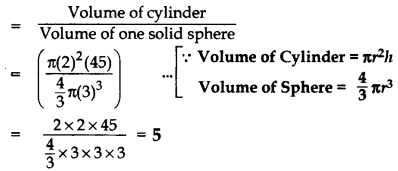
Question 3.
A solid right circular cone is cut into two parts at the middle of its height by a plane parallel to its base. Find the ratio of the volume of the smaller cone to the whole cone. (2012OD)
Solution:
Since the cone is cut from the middle,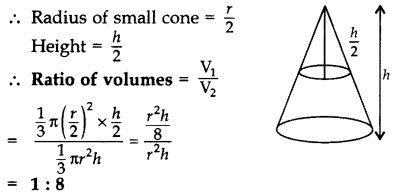
Question 4.
Volume and surface area of a solid hemisphere are numerically equal. What is the diameter of hemisphere? (2017D)
Solution:
Volume of hemisphere = Surface area of hemisphere …[Given
r = 3
∴ Diameter of hemisphere = 27 = 2(3) = 6 cm
Surface Areas and Volumes Class 10 Important Questions Short Answer-I (2 Marks)
Question 5.
If the total surface area of a solid hemisphere is 462 cm2, find its volume. [Take π =
Solution:
Total surface area of hemisphere = 462 cm2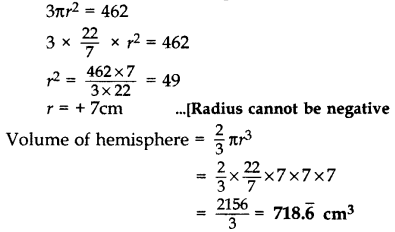
Surface Areas and Volumes Class 10 Important Questions Short Answer-II (3 Marks)
Question 6.
Two cubes, each of side 4 cm are joined end to end. Find the surface area of the resulting cuboid. (2011D)
Solution:
Length of resulting cuboid, I = 2(4) = 8 cm
Breadth of resulting cuboid, b = 4 cm
Height of resulting cuboid, h = 4 cm
Surface area of resulting cuboid
= 2(lb + bh +hl) = 2 [8(4) + 4(4) + 4(8)]
= 2 (32 + 16 + 32) = 2 (80) = 160 cm2
Question 7.
The radii of the circular ends of a bucket of height 15 cm are 14 cm and r сm (r < 14 cm). If the volume of bucket is 5390 cm3, then find the value of r. [Use π =
Solution:
Here h = 15 cm, R = 14 cm,’r’ = r cm
Volume of bucket = 5390 cm3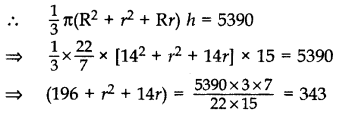
⇒ r2 + 14r + 196 – 343 = 0
⇒ r2 + 14r – 147 = 0 = r2 + 21r – 77 – 147 = 0
⇒ r(r + 21) – 7 (r + 21) = 0
⇒ (r + 21) (r – 7) = 0
⇒ r + 21 = 0 or r – 7 = 0 =
⇒ r = -21 (rejected) or r = 7
..[∵ Radius cannot be negative
∴ Radius, r = 7 cm
Question 8.
Two cubes each of volume 27 cm3 are joined end to end to form a solid. Find the surface area of the resulting cuboid. (2011OD)
Solution:
Volume of a cube = 27 cm3
⇒ (Side)3 = (3)3 ∴ Side = 3 cm
Length of resulting cuboid, l = 2 × 3 = 6 cm
Breadth of resulting cuboid, b = 3 cm
Height of resulting cuboid, h = 3 cm
Surface area of resulting cuboid = 2(lb + bh + hl)
= 2(6 × 3 + 3 × 3 + 3 × 6)
= 2(18 + 9 + 18) = 2(45) = 90 cm2
Question 9.
The sum of the radius of base and height of a solid right circular cylinder is 37 cm. If the total surface area of the solid cylinder is 1628 sq. cm, find the volume of the cylinder. (Use π =
Solution:
Let the radius and height of cylinder be r and h respectively
r + h = 37 cm …(i) [Given
Total surface area of cylinder = 1,628 cm2
2πr(r + h) = 1,628
⇒ 2πr(37) = 1,628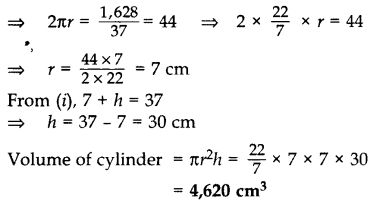
Question 10.
A right circular cone of radius 3 cm, has a curved surface area of 47.1 cm2. Find the volume of the cone. (Use π = 3.14) (2016D)
Solution:
C.S. Area of cone = 47.1 cm2 …[Given
…[Here, r = 3 cm
πrl = 47.1 = (3.14)(3)l = 47.1
Slant height, l =
⇒ r2 + h2 = l2 …[Pythagoras’ theorem
⇒ (3)2 + h2 = (5)2 ⇒ h2 = 25 – 9 = 16
⇒ h = +4 cm
Volume of the cone =
= 3.14(12) = 37.68 cm3
Question 11.
An icecream seller sells his icecreams in two ways: (2012OD)
(A) In a cone of r = 5 cm, h = 8 cm
(B) In a cup in shape of cylinder with r = 5 cm, h = 8 cm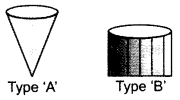
He charges the same price for both but prefers to sell his icecream in a cone.
(a) Find the volume of the cone and the cup.
(b) Which out of the two has more capacity?
Solution:
Volume of type ‘A’
Volume of cone + Volume of hemisphere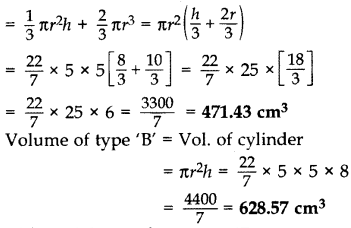
(a) ∴ Volume of a cone = 471.43 cm3
Volume of a cup = 628.57 cm3
(b) Cup has more capacity.
Question 12.
A vessel is in the form of a hemispherical bowl surmounted by a hollow cylinder of same diameter. The diameter of the hemispherical bowl is 14 cm and the total height of the vessel is 13 cm. Find the total (inner) suface area of the vessel. (Use π =
Solution: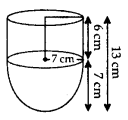
r =
Inner surface area of the vessel = C.S. area of Hemi-sphere + C.S. area of Cylinder
= 2πr2 + 2πrh = 2πr(r + h) …C.S. area = curved surface area
= 2 ×
Question 13.
A solid wooden toy is in the form of a hemisphere surmounted by a cone of same radius. The radius of hemisphere is 3.5 cm and the total wood used in the making of toy is 166
Solution: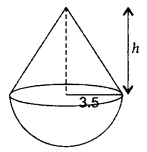
Let the height of cone = h
Radius of cone = Radius of hemisphere = r = 3.5 cm
Volume of solid wooden toy = Volume of hemisphere + Volume of cone
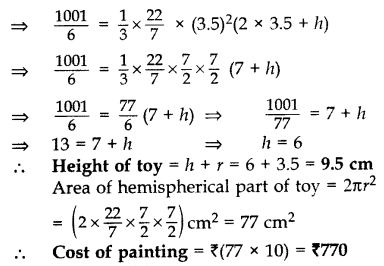
Question 14.
Due to sudden floods, some welfare associations jointly requested the government to get 100 tents fixed immediately and offered to contribute 50% of the cost. If the lower part of each tent is of the form of a cylinder of diameter 4.2 m and height 4 m with the conical upper part of same diameter but of height 2.8 m, and the canvas to be used costs 100 per sq. m, find the amount, the associations will have to pay. (Use π =
Solution:
Let l be the slant height of cone
h be the height of cone = 2.8 m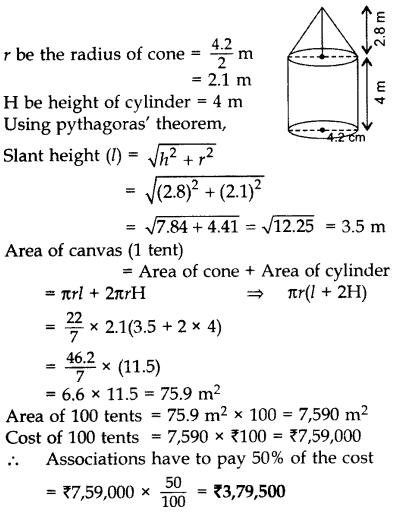
Question 15.
A cubical block of side 10 cm is surmounted by a hemisphere. What is the largest diameter that the hemisphere can have? Find the cost of painting the total surface area of the solid so formed, at the rate of ₹5 per 100 sq. cm. (Use π = 3.14) (2015OD)
Solution:
Let the side of cuboidal block (a) = 10 cm
Let the radius of hemisphere be r.
Side of cube = Diameter of hemisphere Largest possible diameter of hemisphere = 10 cm
∴ Radius, r =
Total surface area = Total surface area of cube + Curved surface area of hemisphere- Area of base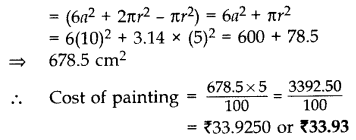
Question 16.
In Figure, is a decorative block, made up of two solids-a cube and a hemisphere. The base of the block is a cube of side 6 cm and the hemisphere fixed on the top has a diameter of 3.5 cm. Find the total surface area of the block. (Use π = 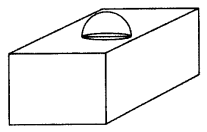
Solution:
Total surface area of the block
= Total surface area of cube + C.S. Area of hemisphere – Area of circle
= 6(side)2 + 2πr2 – πr2
= 6(side)2 + πr2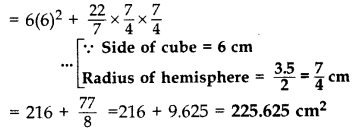
Question 17.
A conical vessel, with base radius 5 cm and height 24 cm, is full of water. This water is emptied into a cylindrical vessel of base radius 10 cm. Find the height to which the water will rise in the cylindrical vessel. (Use π =
Solution:
Let r and I be the radius and height of conical vessel i.e., 5 cm and 24 cm respectively.
Let H be the height of rise in water in cylindrical vessel and R be the radius, i.e., 10 cm.
Volume of water in cylindrical vessel = Volume of water in conical vessel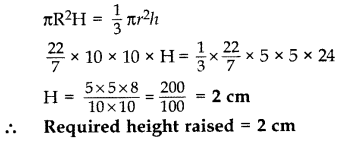
Question 18.
A milkman was serving his customers using two types of mugs A and B of inner diameter 5 cm to Mug‘A Mug‘B’ serve the customers. The height of the mugs is 10 cm. (2012D)
He decided to serve the customers in ‘B’ type of mug.
(a) Find the volume of the mugs of both types.
(b) Which mathematical concept is used in the above problem?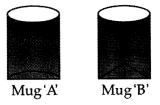
Solution:
(a) Let the radius of cylinder, hemi-sphere and cone be r сm
Let the height of cylinder and cone h1 and h2 respectively.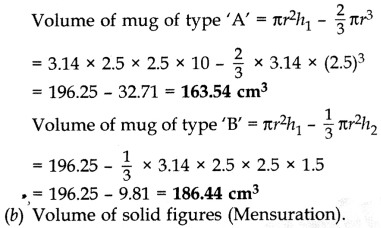
Question 19.
From a solid cylinder of height 7 cm and base diameter 12 cm, a conical cavity of same height and same base diameter is hollowed out. Find the total surface area of the remaining solid. [Use π =
Solution: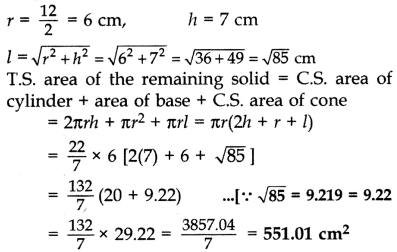
Question 20.
A wooden toy was made by scooping out a hemisphere of same radius from each end of a solid cylinder. If the height of the cylinder is 10 cm, and its base is of radius 3.5 cm, find the volume of wood in the toy. [Use π =
Solution:
Here r = 3.5 cm =
Volume of wood in the toy = Volume of cylinder – 2(Vol. of hemisphere)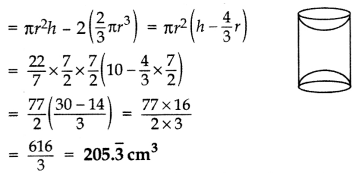
Question 21.
A solid cone of base radius 10 cm is cut into two parts through the mid-point of its height, by a plane parallel to its base. Find the ratio in the volumes of the two parts of the cone. (2013OD)
Solution:
Let BC = r сm and
DE = R = 10 cm
B and C are the mid-points of AD and AE respectively. …[Given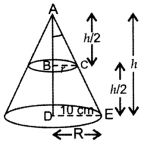
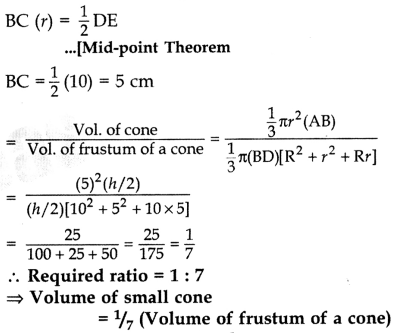
Question 22.
A solid metallic right circular cone 20 cm high and whose vertical angle is 60°, is cut into two parts at the middle of its height by a plane parallel to its base. If the frustum so obtained be drawn into a wire of diameter
Solution:
A solid cone AFE has been cut by BC || FE and
AD ⊥ FE.
∆ADF = ∆ADE (SSS)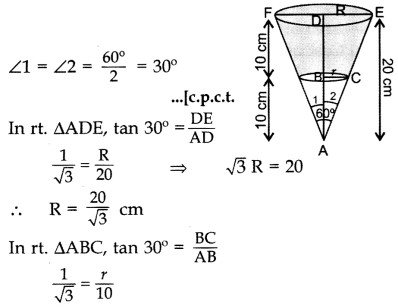
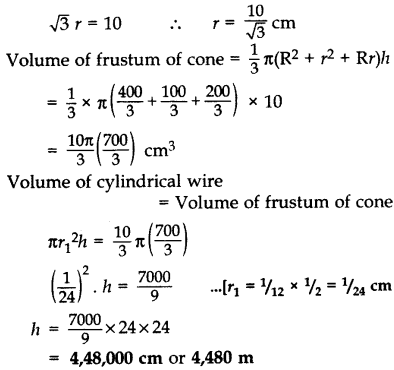
Question 23.
The largest possible sphere is carved out of a wooden solid cube of side 7 cm. Find the volume of the wood left. (Use π =
Solution:
Volume of the wood left = Volume of cube – Volume of sphere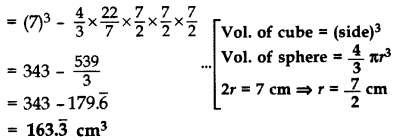
Question 24.
In Figure, from the top of a solid cone of height 12 cm and base radius 6 cm, a cone of height 4 cm is removed by a plane parallel to the base. Find the total surface area of the remaining solid. (Use π = 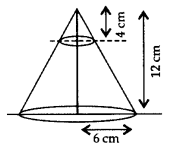
Solution: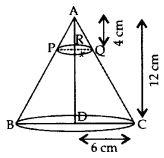
Let AR = 4 cm,
RD = 12 – 4 = 8 cm
Height of frustum (RD),
h = 8 cm Lower radius of frustum (DC),
r1 = 6 cm
We know, ∆ARQ ≅ ∆ADC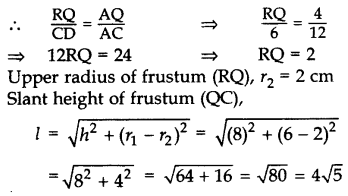
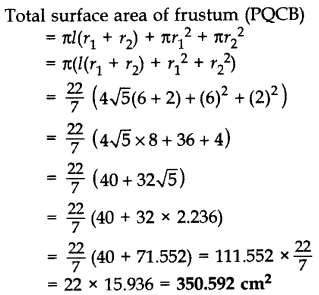
Question 25.
In Figure, from a cuboidal solid metallic block, of dimensions 15 cm × 10 cm × 5 cm, a cylindrical hole of diameter 7 cm is drilled out. Find the surface area of the remaining block. (Use π =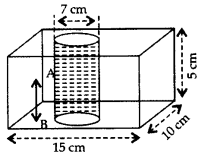
Solution:
Let the length, breadth, height of cuboidal block be 15 cm, 10 cm and 5 cm respectively.
Total surface area of solid cuboidal block
= 2(lb + bh + lh)
= 2(15 × 10 + 10 × 5 + 15 × 5) cm2
= 2(150 + 50 + 75) = 2(275) = 550 cm2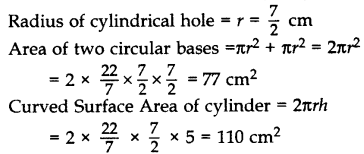
Required area = (Area of cuboidal block – Area of two circular bases + Area of cylinder)
= (550 + 110 – 77) cm2 = 583 cm2
Question 26.
A toy is in the shape of a solid cylinder surmounted by a conical top. If the height and diameter of the cylindrical part are 21 cm and 40 cm respectively, and the height of cone is 15 cm, then find the total surface area of the toy. [π = 3.14, be taken] (2011D)
Solution: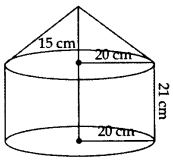
Height of cylinder, H = 21 cm
Height of cone, h = 15 cm
Common radius,
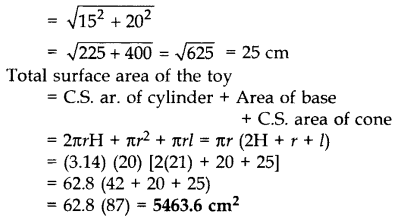
Question 27.
A cone of height 20 cm and radius of base 5 cm is made up of modelling clay. A child reshapes it in the form of a sphere. Find the diameter of the sphere. (2011OD)
Solution:
Volume of the Sphere = Volume of Cone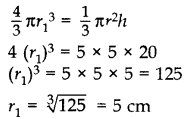
∴ Diameter of the sphere = 2r1 = 2(5) = 10 cm
Question 28.
A cylindrical bucket, 32 cm high and with radius of base 18 cm, is filled with sand. This bucket is emptied on the ground and a conical heap of sand is formed. If the height of the conical heap is 24 cm, then find the radius and slant height of the heap. (2012D)
Solution:
Let x be radius of the conical heap.
Volume of conical heap = Volume of cyl. bucket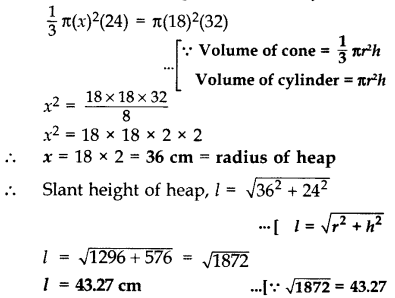
Question 29.
A solid metallic sphere of diameter 8 cm is melted and drawn into a cylindrical wire of uniform width. If the length of the wire is 12 m, find its width. (2013OD)
Solution:
Vol. of cylindrical wire = Volume of solid sphere
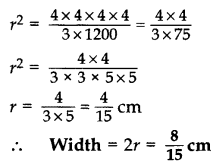
Question 30.
A well of diameter 4 m is dug 21 m deep. The earth taken out of it has been spread evenly all around it in the shape of a circular ring of width 3 m to form an embankment. Find the height of the embankment. (2016D)
Solution:
Radius of well, r = 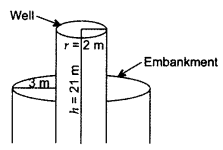
Radius of embankment, R = 2 + 3 = 5 m
Height of the well, h = 21 m
Required height raised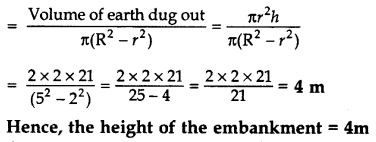
Question 31.
A sphere of diameter 12 cm, is dropped in a right circular cylindrical vessel, partly filled with water. If the sphere is completely submerged in water, the water level in the cylindrical vessel rises by 3
Solution:
Radius of sphere, r =
Let h be the height of risen water level i.e., 3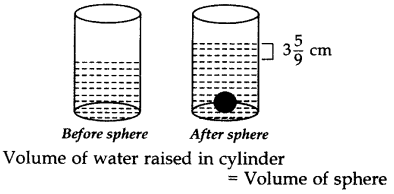
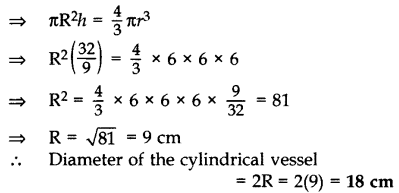
Question 32.
A solid sphere of radius 10.5 cm is melted and recast into smaller solid cones, each of radius 3.5 cm and height 3 cm. Find the number of cones so formed. (Use π =
Solution: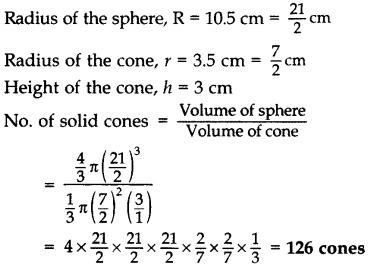
Question 33.
The
Solution: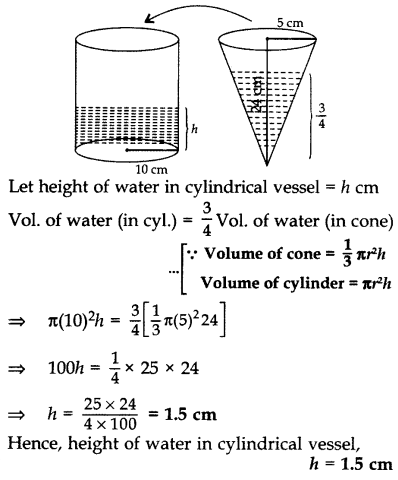
Question 34.
504 cones, each of diameter 3.5 cm and height 3cm, are melted and recast into a metallic sphere. Find the diameter of the sphere and hence find its surface area. (Use π =
Solution:
Let the radius of sphere (R) = ?
Let the radius of cone (r) =
Let the height of cone (h) = 3 cm
Volume of metal in 1 cone =
Volume of metal in 504 cones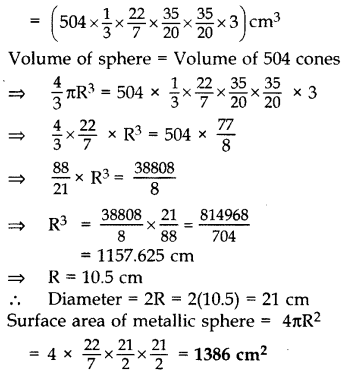
Question 35.
A farmer connects a pipe of internal diameter 20 cm from a canal into a cylindrical tank which is 10 m in diameter and 2 m deep. If the water flows through the pipe at the rate of 4 km per hour, in how much time will the tank be filled completely? (2014D)
Solution: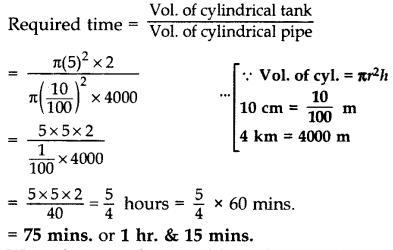
Question 36.
Water in a canal, 6 m wide and 1.5 m deep, is flowing at a speed of 4 km/h. How much area will it irrigate in 10 minutes, if 8 cm of standing water is needed for irrigation? (2014OD)
Solution:
Speed of water = 4 km/hr
Canal, l = 4 × 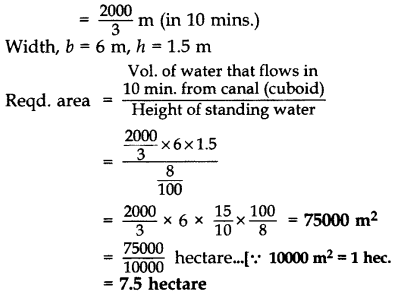
Question 37.
A hemispherical bowl of internal diameter 36 cm contains liquid. This liquid is filled into 72 cylindrical bottles of diameter 6 cm. Find the height of the each bottle, if 10% liquid is wasted in this transfer. (2015OD)
Solution:
Let the radius of hemispherical bowl,
(R) =
Let the radius of cylindrical bottle (r) =
Let the height of cylindrical bottle be h = ?
Vol. of liquid in the hemispherical bowl = 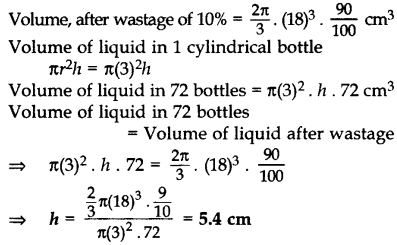
Question 38.
An open metal bucket is in the shape of a frustum of a cone of height 21 cm with radii of its lower and upper ends as 10 cm and 20 cm respectively. Find the cost of milk which can completely fill the bucket at ₹30 per litre. [Use π =
Solution:
Here h = 21 cm, r = 10 cm, R = 20 cm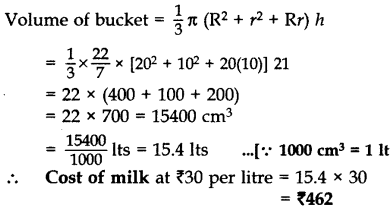
Question 39.
A toy is in the form of a cone mounted on a hemisphere of same radius 7 cm. If the total height of the toy is 31 cm, find its total surface area. (Use π =
Solution: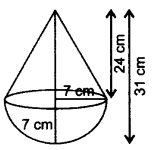
Radius = 7 cm
Vertical height of cone,
h = 31 – 7 = 24 cm
Slant height,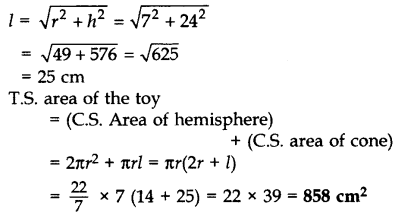
Question 40.
In Figure, a tent is in the shape of a cylinder surmounted by a conical top of same diameter. If the height and diameter of cylindrical part are 2.1 m and 3 m respectively and the slant height of conical part is 2.8 m, find the cost of canvas needed to make the tent if the canvas is available at the rate of ₹500/sq. metre. (Use π = 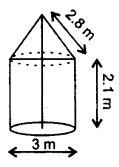
Solution: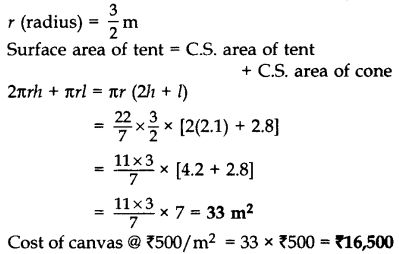
Surface Areas and Volumes Class 10 Important Questions Long Answer (4 Marks)
Question 41.
A solid is in the shape of a cone standing on a hemisphere with both their radii being equal to 7 cm and the height of the cone is equal to its diameter. Find the volume of the solid. [Use π =
Solution:
Radius, r = 7 cm
Height of cone, h = 2(7) = 14 cm
Volume of solid = Vol. of hemisphere + Volume of cone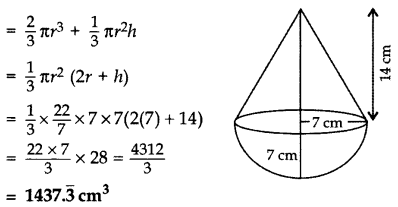
Question 42.
A hemispherical tank, full of water, is emptied by a pipe at the rate of
Solution: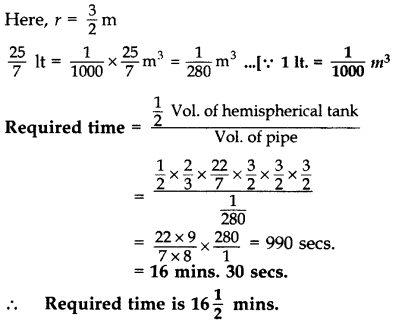
Question 43.
Water is flowing through a cylindrical pipe, of internal diameter 2 cm, into a cylindrical tank of base radius 40 cm, at the rate of 0.4 m/s. Determine the rise in level of water in the tank in half an hour. (2013D)
Solution:
Radius of tank, r1 = 40 cm
Internal radius of cylindrical pipe, r2 =
Let the height of rises water, h1 = ?
Length of water flow in 1 second = 0.4 m
=
∴ Length of water flow in 30 minutes, h2
= 40 × 60 × 30 = 72,000 cm
Volume of water in cylinder tank
= Volume of water flow from cylindrical pipe in half an hour
∴ Level of water in cylinder tank rises in half an hour, h1 = 45 cm
Question 44.
150 spherical marbles, each of diameter 1.4 cm, are dropped in a cylindrical vessel of diameter 7 cm containing some water, which are completely immersed in water. Find the rise in the level of water in the vessel. (2014OD)
Solution: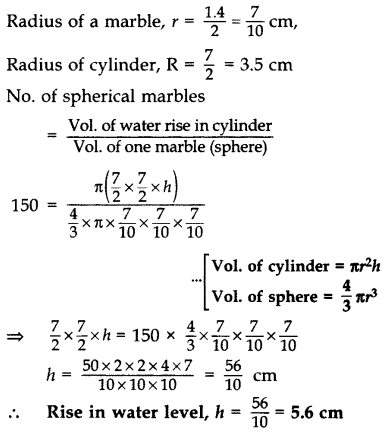
Question 45.
From a solid cylinder of height 2.8 cm and diameter 4.2 cm, a conical cavity of the same height and same diameter is hollowed out. Find the total surface area of the remaining solid. (Take π =
Solution: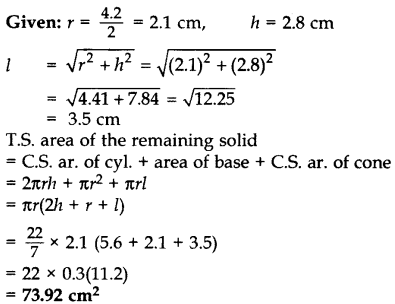
Question 46.
Water is flowing at the rate of 2.52 km/hr. through a cylindrical pipe into a cylindrical tank, the radius of whose base is 40 cm. If the increase in the level of water in the tank, in half an hour is 3.15 m, find the internal diameter of the pipe. (2015D)
Solution:
Let r be the internal radius of the pipe.
Radius of base of tank, R = 40 cm
=
Level of water raised in the tank (H) = 3.15 m
If the flow rate in an hour = 2.52 km = 2520 m
Then, the flow rate in half an hour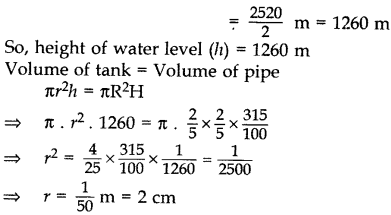
∴ Internal diameter of pipe = 2r = 2 × 2 = 4 cm
∴ Internal diameter of pipe = 4 cm
Question 47.
From each end of a solid metal cylinder, metal was scooped out in hemispherical form of same diameter. The height of the cylinder is 10 cm and its base is of radius 4.2 cm. The rest of the cylinder is melted and converted into a cylindrical wire of 1.4 cm thickness. Find the length of the wire. [Use π =
Solution:
Let h be the height of cylinder = 10 cm
Let r be the radius of cylinder = 4.2 cm
Radius of cylinder
= Radius of hemispherical metal = r = 4.2 cm ..[Given
Total Volume of cylinder = πr2h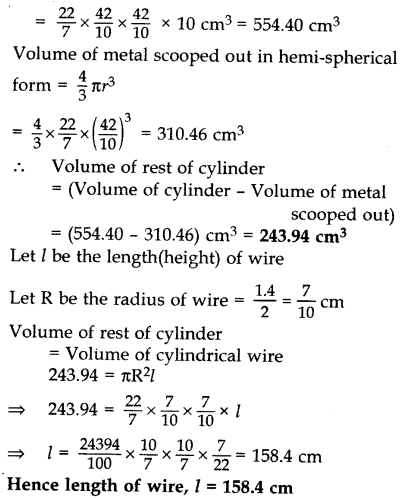
Question 48.
A bucket open at the top is in the form of a frustum of a cone with a capacity of 12308.8 cm3. The radii of the top and bottom circular ends are 20 cm and 12 cm respectively. Find the height of the bucket and the area of metal sheet used in making the bucket. (Use π = 3.14) (2016D)
Solution:
Radius of the top of bucket, R = 20 cm
Radius of the bottom of bucket, r = 12 cm
Voulume of bucket = 12308.8 cm3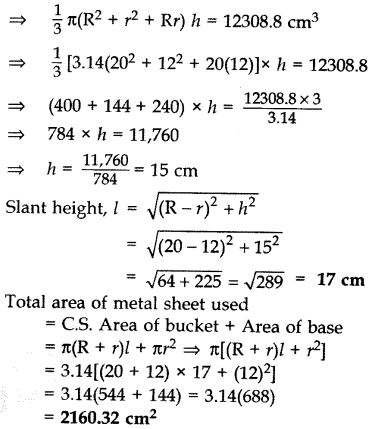
Question 49.
A container shaped like a right circular cylinder having base radius 6 cm and height 15 cm is full of ice-cream. The ice-cream is to be filled into cones of height 12 cm and radius 3 cm, having a hemispherical shape on the top. Find the number of such cones which can be filled with ice-cream. (2012D)
Solution:
Volume of cylinder = πr2h
Volume of ice-cream cone = 1/3 πr21h1
Volume of hemispherical top of ice-cream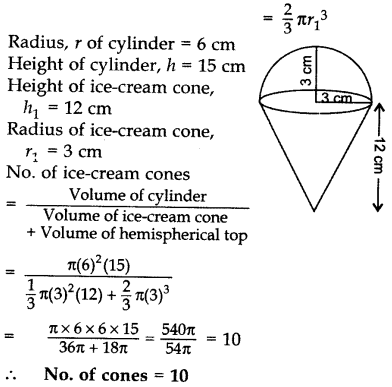
Question 50.
A military tent of height 8.25 m is in the form of a right circular cylinder of base diameter 30 m and height 5.5 m surmounted by a right circular cone of same base radius. Find the length of the canvas used in making the tent, if the breadth of the canvas is 1.5 m. (2012OD)
Solution: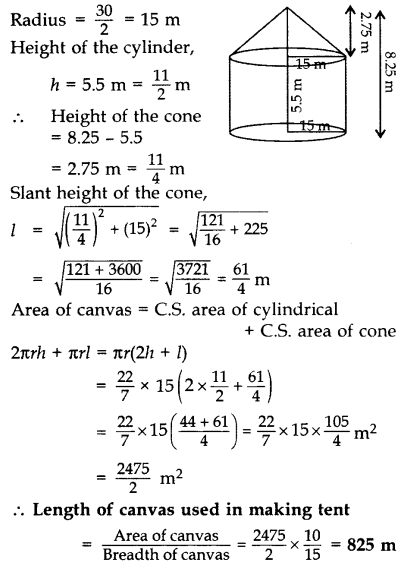
Question 51.
A well of diameter 4 m is dug 14 m deep. The earth taken out is spread evenly all around the well to form a 40 cm high embankment. Find the width of the embankment. (2015D)
Solution:
Let h be the height of well and r be the radius of well.
h = 14 m, r=
Volume of earth taken out after digging the well = πr2h
=
Let x be the width of embankment formed by using (i),
∴ Total width of well including embankment (R) = 2 + x
Height of embankment (H) = 40 cm =
Volume of well = Volume of embankment So, Volume of embankment = T(R2 – r2)H = 176 …[From (i)![]()
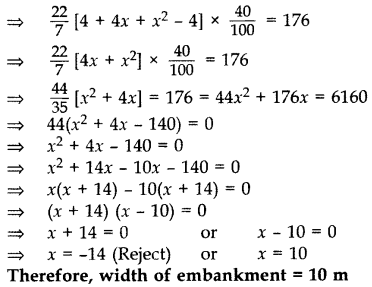
Question 52.
A tent consists of a frustum of a cone, surmounted by a cone. If the diameter of the upper and lower circular ends of the frustum be 14 m and 26 m respectively, the height of the frustum be 8 m and the slant height of the surmounted conical portion be 12 m, find the area of canvas required to make the tent. (Assume that the radii of the upper circular end of the frustum and the base of surmounted conical portion are equal). (2014OD)
Solution:
Upper radius of frustum of a cone,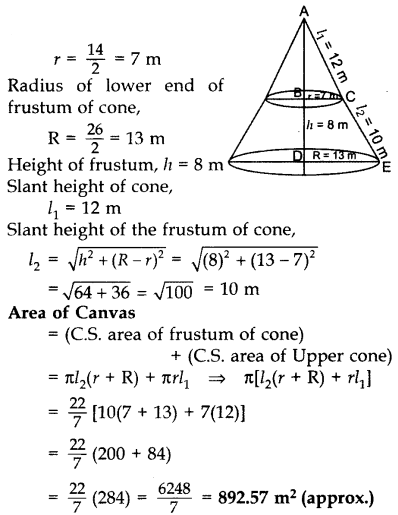
Question 53.
Water is flowing at the rate of 15 km/hour through a pipe of diameter 14 cm into a cuboidal pond which is 50 m long and 44 m wide. In what time will the level of water in the pond rise by 21 cm? (2011OD)
Solution:
H = 15 km = 15000 m (1 km = 1000 m)
Radius of pipe (t) =
Volume of pipe (cylinder) = πr2H
∴ Volume of water flowing through the cylindrical pipe in an hour at the rate of 15 km/hr.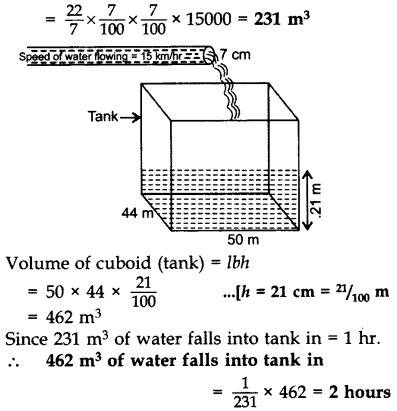
Question 54.
Water is flowing at the rate of 10 km/hour through a pipe of diameter 16 cm into a cuboidal tank of dimensions 22 m × 20 m × 16 m. How long will it take to fill the empty tank? [Use π =
Solution: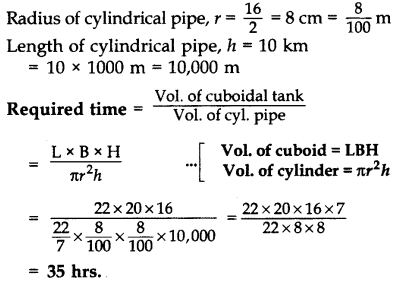
Question 55.
A drinking glass is in the shape of the frustum of a cone of height 14 cm. The diameters of its two circular ends are 4 cm and 2 cm. Find the capacity of the glass. [Use π =
Solution: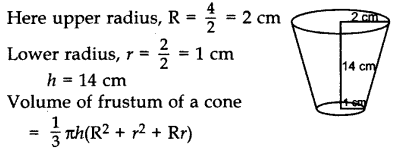
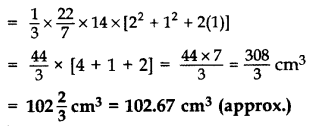
Question 56.
A bucket open at the top, and made up of a metal sheet is in the form of a frustum of a cone. The depth of the bucket is 24 cm and the diameters of its upper and lower circular ends are 30 cm and 10 cm respectively. Find the cost of metal sheet used in it at the rate of 10 per 100 cm2. (Use π = 3.14) (2013D)
Solution:
Depth of bucket, h = 24 cm
Radius of top bucket,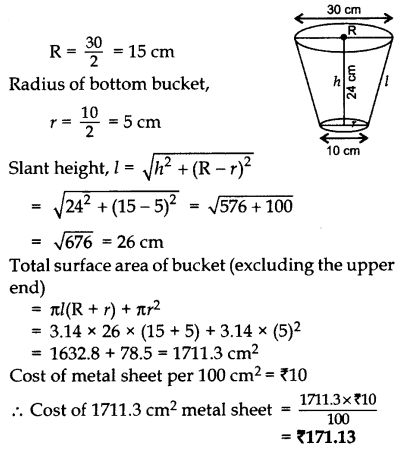
Question 57.
The slant height of a frustum of a cone is 4 cm and the perimeters of its circular ends are 18 cm and 6 cm. Find the curved surface area of the frustum. (2017OD)
Solution:
Let longer radius = R cm
Smaller radius = r cm
2πR = 18 and 2πr = 6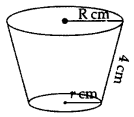
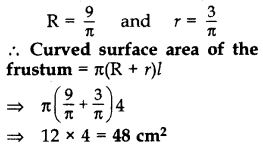
Question 58.
Sushant has a vessel, of the form of an inverted cone, open at the top, of height 11 cm and radius of top as 2.5 cm and is full of water. Metallic spherical balls each of diameter 0.5 cm are put in the vessel due to which
Solution:
Numbers of spherical balls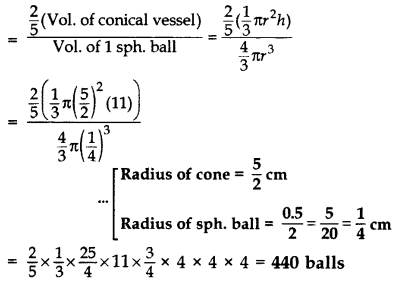
Question 59.
A 21 m deep well with diameter 6 m is dug and the earth from digging is evenly spread to form a platform 27 m × 11 m. Find the height of the platform. (Use π =
Solution:
Let h be the height of well, h = 21 m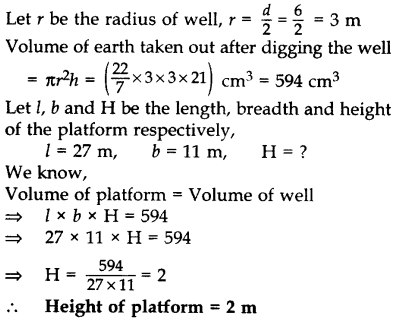
Question 60.
The dimensions of a solid iron cuboid are 4.4 m × 2.6 m × 1.0 m. It is melted and recast into a hollow cylindrical pipe of 30 cm inner radius and thickness 5 cm. Find the length of the pipe. (2017OD)
Solution: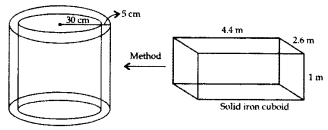
Inner radius, r = 30 cm = 0.30 m
Outer radius, R = (30 + 5) cm = 35 cm or 0.35 m
As per the question: (Volume of hollow Cylindrical pipe) = (Volume of solid iron cuboid)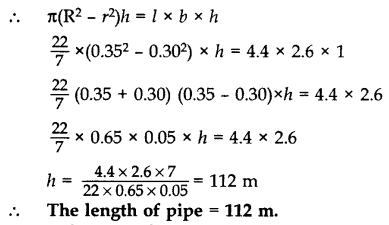
Question 61.
In a rain-water harvesting system, the rain water from a roof of 22 m × 20 m drains into a cylindrical tank having diameter of base 2 m and height 3.5 m. If the tank is full, find the rainfull in cm. (2017OD)
Solution:
Let the rainfall be x m.
Volume of water on the roof = Volume of cylindrical tank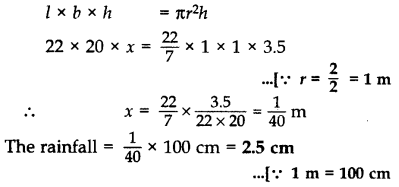
Question 62.
A bucket is in the form of a frustum of a cone and it can hold 28.49 litres of water. If the radii of its circular ends are 28 cm and 21 cm, find the height of the bucket. (Use π =
Solution:
Here R = 28 cm, r = 21 cm
Volume of Bucket = 28.49 litres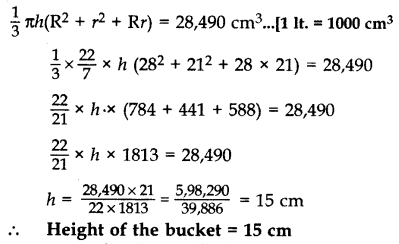
Question 63.
Water running in a cylindrical pipe of inner diameter 7 cm, is collected in a container at the rate of 192.5 litres per minute. Find the rate of flow of water in the pipe in km/h. (Use π =
Solution:
Volume of water that flows for one hour
= (192.50 × 60) Its.
= 192.50 × 60 × 1000 cm3 …[∵ 1 lt. 1000 cm3
Inner radius of the cylindrical pipe =
Let h cm be the length of the volume of water that flows in one hour.
Volume of water that flows in 1 hr. = πr2h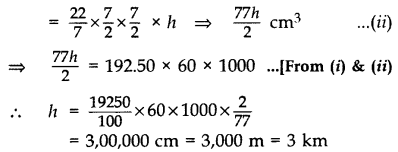
Hence the rate of flow of water in the pipe = 3 km/hr.
Question 64.
Due to heavy floods in a State, thousands were rendered homeless. 50 schools collectively offered to the State Government to provide place and the canvas for 1,500 tents to be fixed by the Government and decided to share the whole expenditure equally. The lower part of each tent is cylindrical of base radius 2.8 m and height 3.5 m, with conical upper part of same base radius but of height 2.1 m. If the canvas used to make the tents coşts ₹120 per sq. m, find the amount shared by ‘each school to set up the tents. (2016OD)
Solution: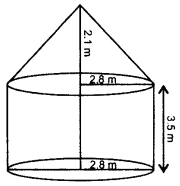
Let r and h be the radius and height of cylindrical part respectively and I be the slant height of conical part.
Slant height of conical part (l),
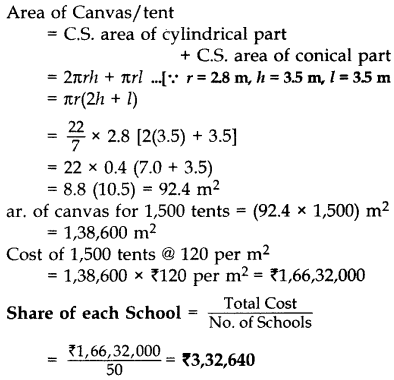
Question 65.
A container, open at the top and made up of metal sheet is in the form of a frustum of a cone of height 16 cm with diameters of its lower and upper ends as 16 cm and 40 cm respectively. Find the cost of metal sheet used to make the container, if it costs 10 per 100 cm2. [Take a = 3.14] (2013OD)
Solution:
Height of frustum of a cone, h = 16 cm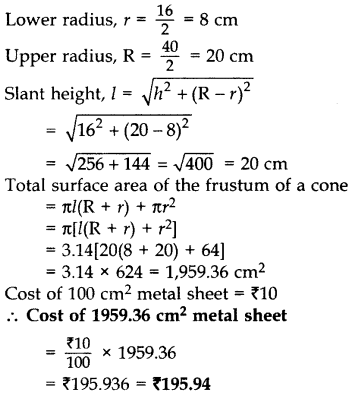
Class 10 Maths Notes Chapter 13 Surface Areas and Volumes
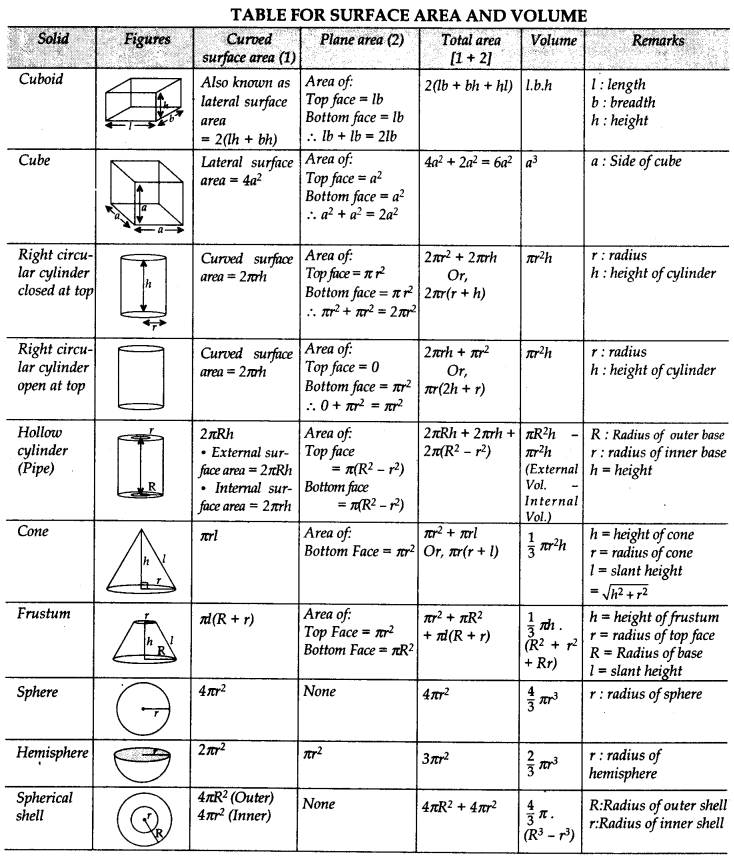
SURFACE AREA AND VOLUME OF COMBINATIONS
Cone on a Cylinder.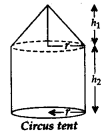
r = radius of cone & cylinder;
h1 = height of cone
h2 = height of cylinder
Total Surface area = Curved surface area of cone + Curved surface area of cylinder + area of circular base
= πrl + 2πrh2 +πr2;
Slant height, l =
Total Volume = Volume of cone + Volume of cylinder
=
Cone on a Hemisphere: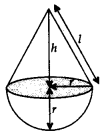
h = height of cone;
l = slant height of cone =
r = radius of cone and hemisphere
Total Surface area = Curved surface area of cone + Curved surface area of hemisphere = πrl + 2πr2
Volume = Volume of cone + Volume of hemisphere =
Conical Cavity in a Cylinder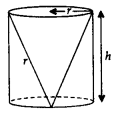
r = radius of cone and cylinder;
h = height of cylinder and conical cavity;
l = Slant height
Total Surface area = Curved surface area of cylinder + Area of the bottom face of cylinder + Curved surface area of cone = 2πrh + πr2 + πrl
Volume = Volume of cylinder – Volume of cone =
Cones on Either Side of the Cylinder.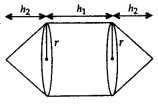
r = radius of cylinder and cone;
h1 = height of the cylinder
h2 = height of cones
Slant height of cone, l =
Surface area = Curved surface area of 2 cones + Curved surface area of cylinder = 2πrl + 2πrh1
Volume = 2(Volume of cone) + Volume of cylinder =
Cylinder with Hemispherical Ends.
r = radius of cylinder and hemispherical ends;
h = height of cylinder
Total surface area= Curved surface area of cylinder + Curved surface area of 2 hemispheres = 2πrh + 4πr2
Volume = Volume of cylinder + Volume of 2 hemispheres =
Hemisphere on Cube or Hemispherical Cavity on Cube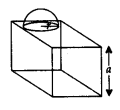
a = side of cube;
r = radius of hemisphere.
Surface area = Surface area of cube – Area of hemisphere face + Curved surface area of hemisphere
= 6a2 – πr2 + 2πr2 = 6a2 + πr2
Volume = Volume of cube + Volume of hemisphere =
Hemispherical Cavity in a Cylinder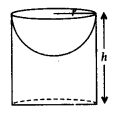
r = radius of hemisphere;
h = height of cylinder
Total surface area = Curved surface area of cylinder + Surface area of base + Curved surface area of hemisphere
= 2πrh + πr2 + 2πr2 = 2πrh + 3πr2
Volume = Volume of cylinder – Volume of hemisphere =
.png)
.png)